'Walking back to happiness - whoompa - oh, yeah-yeah!' The year Is 1961 and 14 year-old schoolgirl Helen Shapiro is storming up the charts with her first No 1 smash hit, joining the pop aristocrats of the day. Back then I had a schoolboy 'crush' on the then 'Queen of 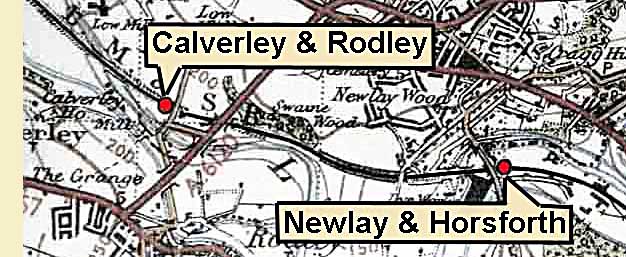 Pop', but her hit-making career lasted only two years in the chiefly male-dominated hit parade: Elvis, Cliff, Adam Faith, Marty Wilde, Jess Conrad, Billy Fury and a spiky-haired Joe Brown. By 1964, however, the music scene was to change forever. I'm talking about the 'Liverpool Sound' which knocked spots off everything in the charts.
Pop', but her hit-making career lasted only two years in the chiefly male-dominated hit parade: Elvis, Cliff, Adam Faith, Marty Wilde, Jess Conrad, Billy Fury and a spiky-haired Joe Brown. By 1964, however, the music scene was to change forever. I'm talking about the 'Liverpool Sound' which knocked spots off everything in the charts.
Against a backdrop of Beatles' smash hits, countless thousands of youngsters set about the task of photographing steam before it vanished from the scene.
That's why I'd made a start on photographing the Aire Valley line before it was too late...
Thirty-odd years later, however, and it has all ended up in tears...in 1991 I stupidly dropped a lighted cigarette among my boxes of treasured railway memorabilia...whooomph! The whole lot went up in flames.
Oh dear, the fire damage was worse than I ever imagined. On searching through the smouldering scrag ends I discovered the majority of my 35mm railway negatives had turned into a pile of ash and my prized collection of colour transparencies had melted into a solidified lump of plastic. I managed to save 30 slides mounted in glass slide holders, but the remainder had been stored in unprotected card mounts and contained no celluloid whatsoever.
The memorabilia I lost in that fire was stomach-churning - it meant more to me than anything in the world - a  pageant of memories gone up in smoke forever.
pageant of memories gone up in smoke forever.
Well, not quite...I still have some old photos and my battered 50-odd year-old photo diary somehow survived; the scorched pages (below) show details of photos taken in October 1960; it includes a note of the locomotive, date, location, shutter speed and f-stops…the exposure details were important as I didn't have a light meter. Okay, perhaps my naïve interpretation of train workings and misspelling of Calverley were careless, but one of the biggest surprises are the different filters and 35mm films I experimented with - Ilford FP3, Kodak Panotamic X, Kodak Plus X Pan and Adox KB17.
And why am I telling you all this? Well, the digital age has changed everything; it makes photography so much simpler nowadays but we can't afford to be blasé; it only takes a nano-second for a computer to crash and I'd hate you to go through the anguish of losing your own prized photos. It's important to regularly back up your computer...
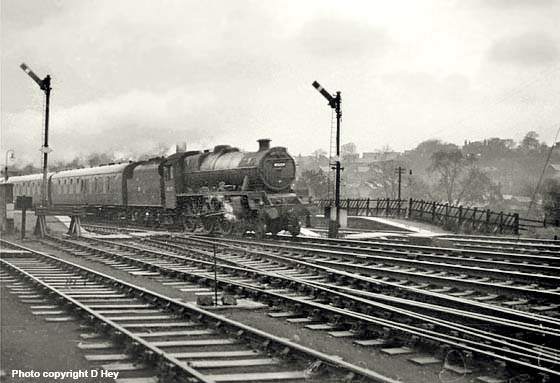
(Above-Below) The highlight of a young spotter's trip to Newlay & Horsforth station during steam days was watching the stately procession of two Anglo-Scottish expresses - 'Thames-Clyde' and 'Waverley' - which ran in both directions. The above photo shows 'Jubilee' class No 45639 Raleigh heading the southbound 'Waverley' express, while in the photo (below) 'Britannia' class No 70044 Earl Haigh leans to the curve with the 'up' 'Thames-Clyde Express'. The height of the camber on the 'up' slow line necessitated a set of mobile steps on the platform to assist elderly or infirm passengers when embarking and alighting from trains. 
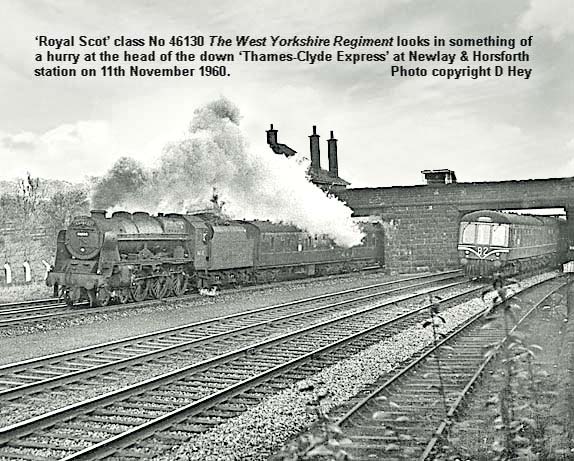

(Above-Below) A little over a year after closure and nature is beginning to take over the abandoned platforms; 'Peak' class D17 heads the 10.15am Leeds-Glasgow on 6th August 1966. In January 1959, all local trains between Leeds and Bradford to Ilkley and Skipton were dieselised, but despite the economies the new dmu service brought, closures could not be prevented. In 1965, seven intermediate stations were closed on the Aire Valley route between Leeds City and Bradford Forster Square, including Newlay & Horsforth. This Class 108 2-car set is working a Leeds City-Ilkley service in September 1960.
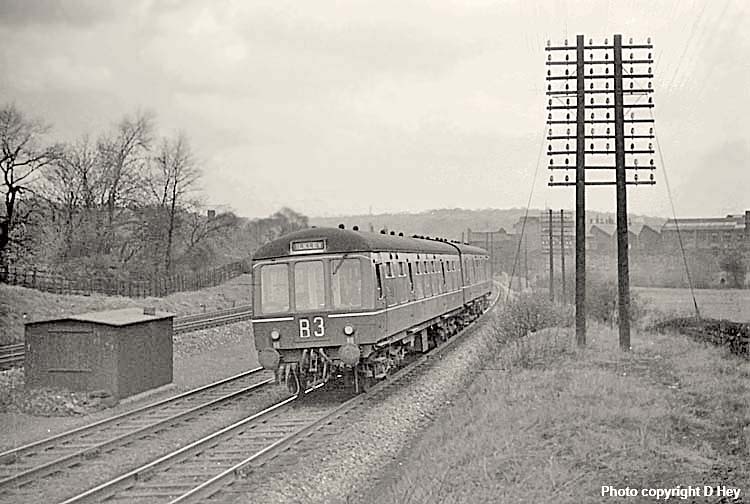

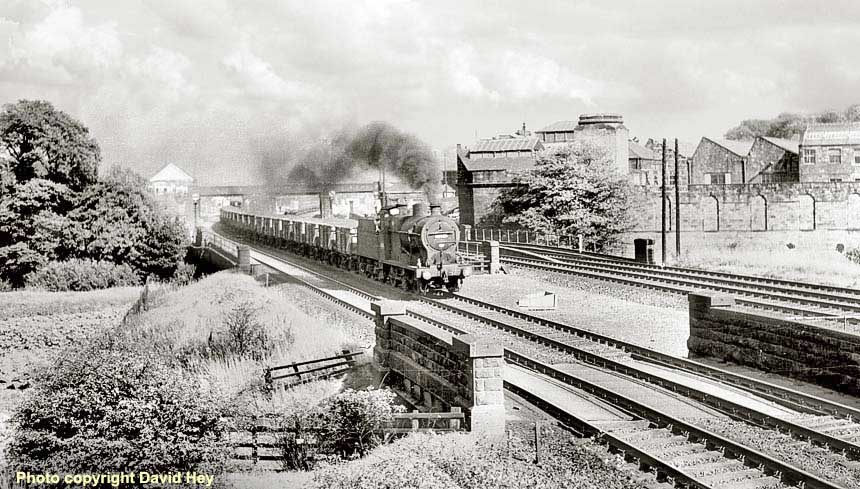
(Above-Below) Labouring with a heavy rake of coal wagons, a Class 4F fills the air with smoke as it crosses the Aire river on the 'down' slow line. Note the banner signals in the background and an early-liveried dmu forming the Bradford (Forster Square) Leeds City service making its obligatory stop at Newlay & Horsforth station. (Below) The same heavy coal train on another day...the Class 4F wheezed through Newlay cutting marginally faster than a glacier, the crew clearly struggling; why the operating department couldn't provide a more powerful Class 8F for this working I don't know!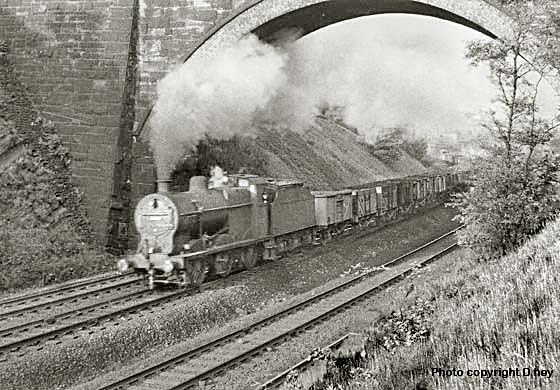
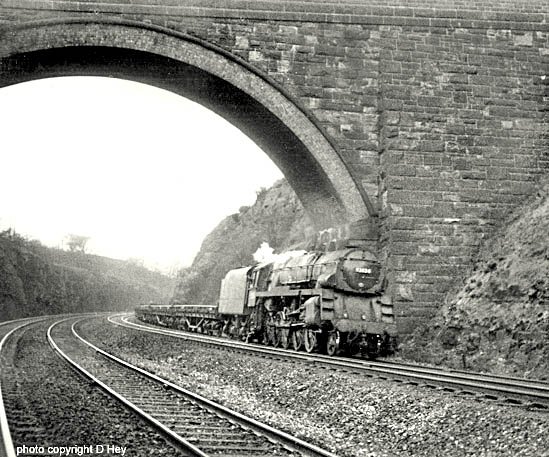
(Above-Below) In an effort to conserve energy, an experimental variation of the Class 9F 2-10-0s appeared on the London Midland Region when ten locomotives, Nos 92020-92029, were built incorporating the Italian Franco-Crosti double boiler. The design was aimed at increasing thermal efficiency by re-using the firebox gases and redirecting them through a second drum beneath the boiler to pre-heat the water feed. The Crosti 9F's exhaust was expelled from a chimney slotted into the running plate, but this often led to unpleasant conditions for footplatemen with trailing smoke often obscuring the driver's vision. Soon after the ten Crosti 9Fs were introduced to traffic the decision was taken to abandon steam in favour of diesel and electric traction and the short-lived Crosti experiment was subsequently discontinued. Here No 92024 heads an 'up' train of rails through Newlay cutting. (Below) 'Jubilee' class No 45739 Ulster makes light work of a parcels train from Leeds to Carlisle. 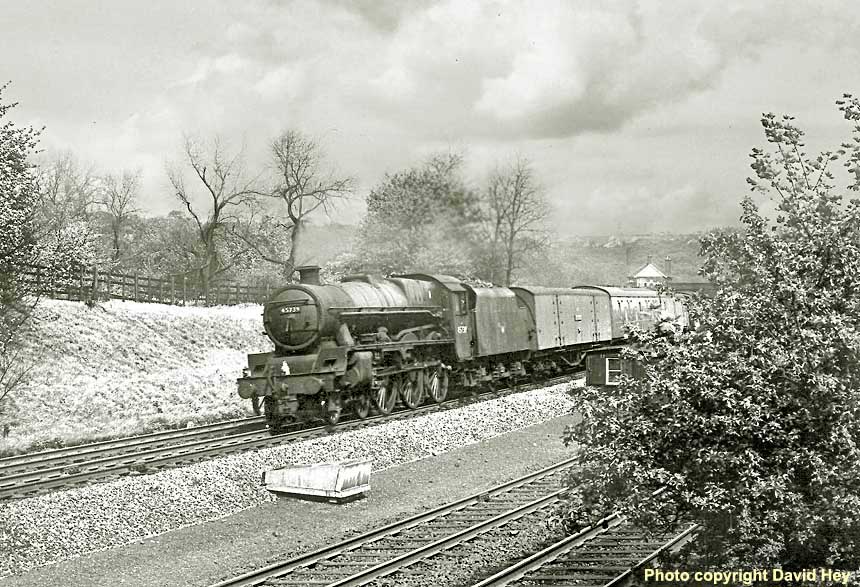
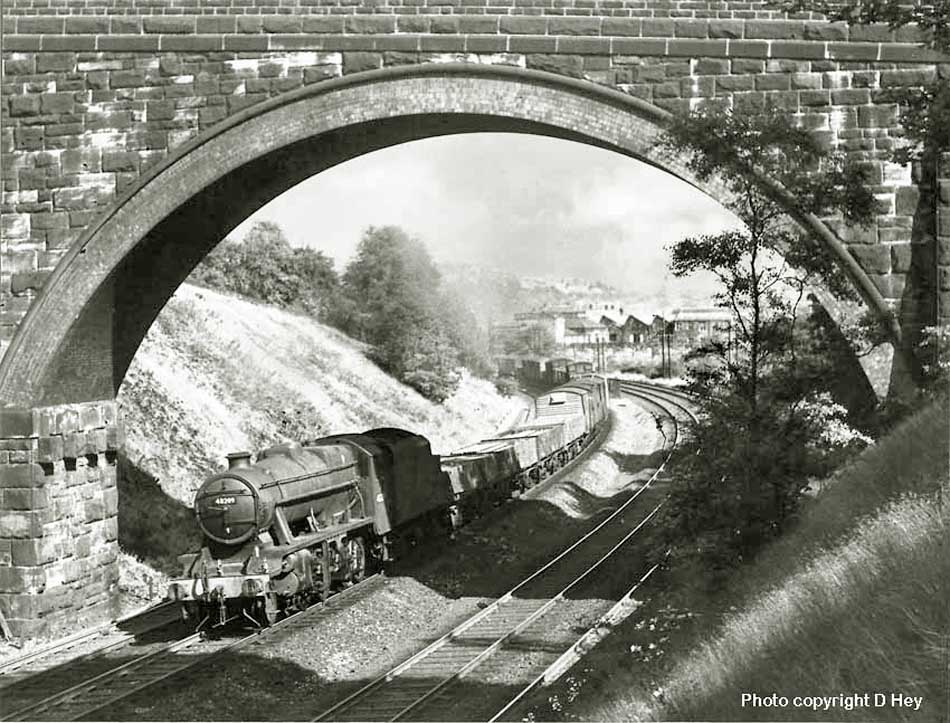
(Above-Below) It's extraordinary how a set of old photographs can whisk you back to a moment in the past, overwhelming you with vivid, sometimes quite forgotten memories of childhood spotting days. One such place for me was the remoteness of Newlay Cutting; it became a veritable hiding place where I could indulge my passion for watching trains without any bigoted gazes heading my way…the spotting fraternity was stigmatised even then. Here Class 8F No 48209 heads a Leeds-Carlisle goods on June 11th 1962. Amazingly, the Class 8F (introduced in 1935) was still doing the job for which it was built right up to the end of steam days in 1968...a fitting testimony to Stanier's design. (Below) In the opposite direction No 48084 trundles by with a rake of coal empties. 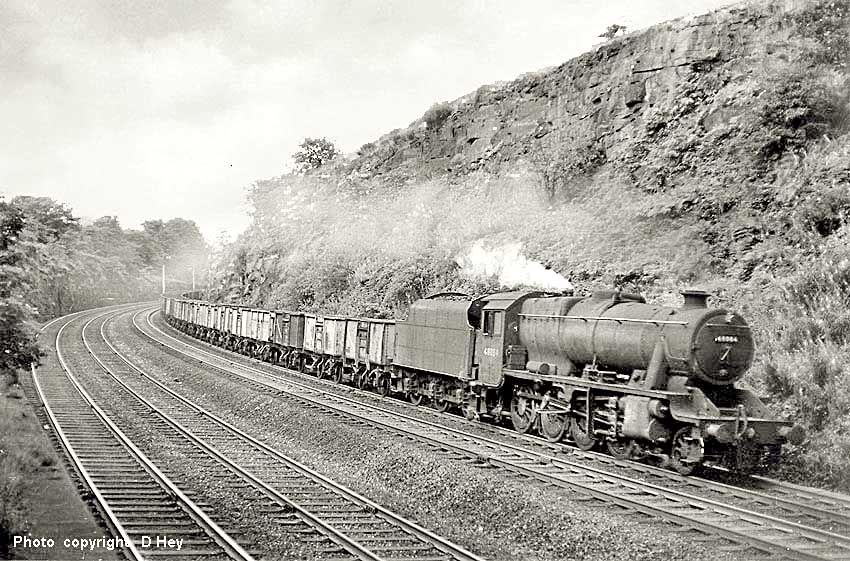
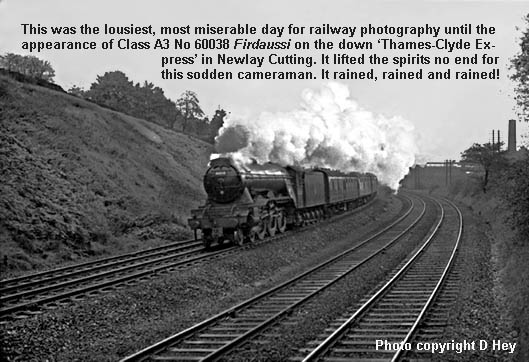

With hindsight I must have cut a rather reclusive, enigmatic figure to the indigenous wildlife in the cutting; I'd sit there for hours on end beneath the overhanging trees, spending most of the day shaded from the sunlight shimmering through the canopy of leaves. Most spotters have a love of the great outdoors and the solitude in the cutting was as close as I could get to nature. In between the stately passage of trains (steam still carried considerable clout in those days) the peace and tranquility was a rural idyll that few railway photographers knew about and so I claimed it as my own.
(Above-Below) Due to the hasty abandonment of the pilot scheme orders, construction of the BR/Sulzer Type 2 produced many changes before a satisfactory design was finally evolved. The clutter of engine room ventilation louvres on the early Type 2s was a poor design feature as they allowed dirt to enter the engine room. Hidden under the grime of No D5224 (heading a Morecambe-Leeds train) is a two-tone green livery. (Below) As steam eked out its final days in a poor state of disrepair, it became increasingly difficult for the operating department to find a suitable steam locomotive with a power classification relative to its train formation; either being too heavy or too light for the purpose. The introduction of diesel multiple units (dmus) offered a practical solution to this problem as the engines of several railcars could be coupled together to meet varying traffic needs, therefore the power available became proportional to the length of the train. In this view, a Black 5 heads a lightweight Carlisle-Leeds train alongside an 8-car BRCW (Class 104) on a SO Bradford Forster Square-Scarborough service out of the cutting near Newlay & Horsforth in June 1962.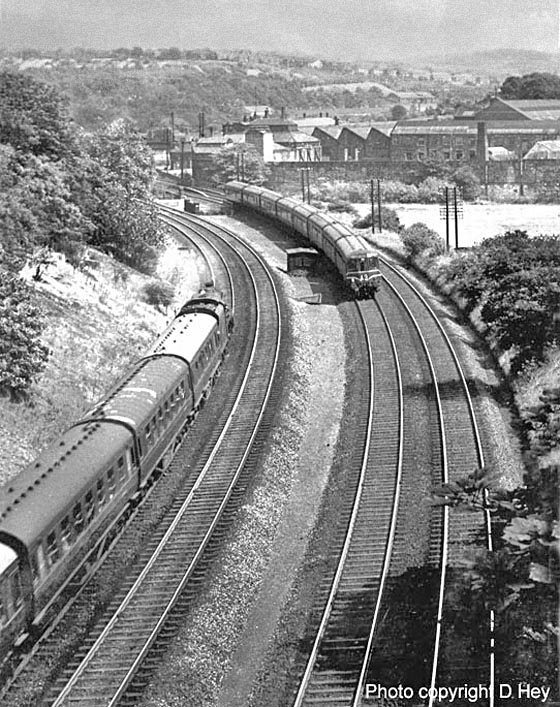

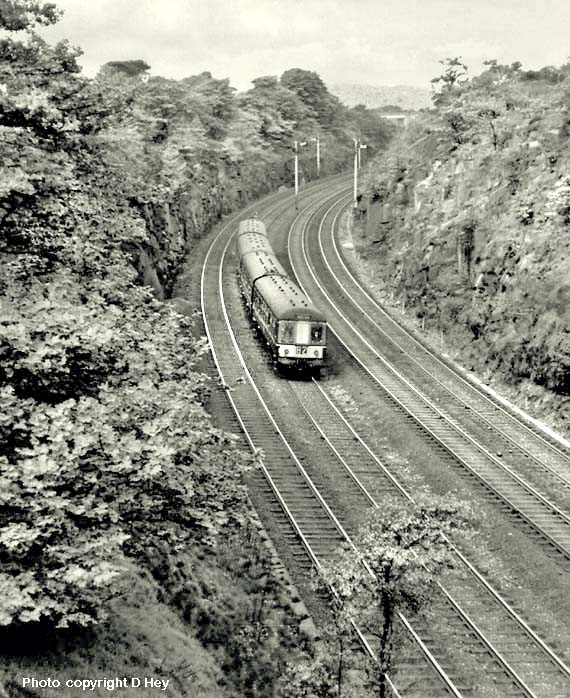
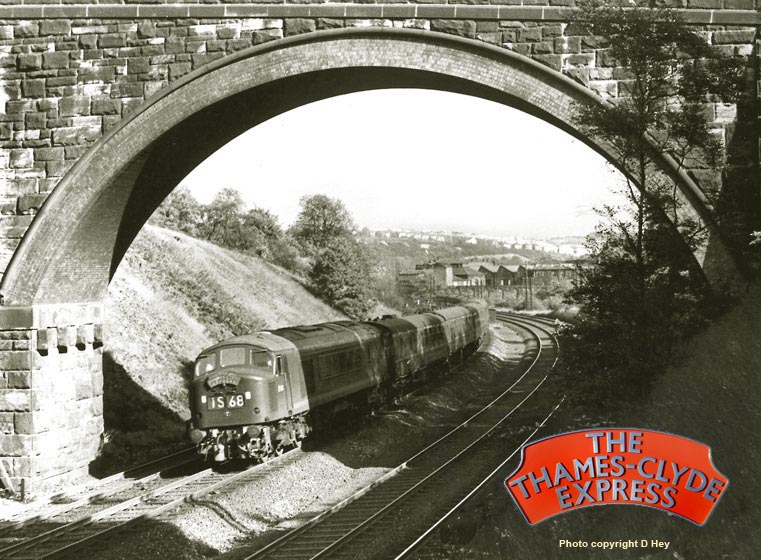
(Above-Below) The Anglo-Scottish 'Waverley' and 'Thames-Clyde' became diesel-hauled throughout from the start of the 1961 summer timetable. The named train headboards added a certain panache to diesel-hauled expresses, but such extravagances were soon to disappear. The bulky 'Thames-Clyde' headboard did not sit easily on the top lamp iron of the 'Peak' class locomotives, as can be seen in this shot above of the train heading through Newlay Cutting. (Below) Fast-forward a few years and the headboard is missing on 'Peak' class No D147 (later 46010) heading the 1S68 northbound 'Thames-Clyde' through Newlay Cutting in August 1965. 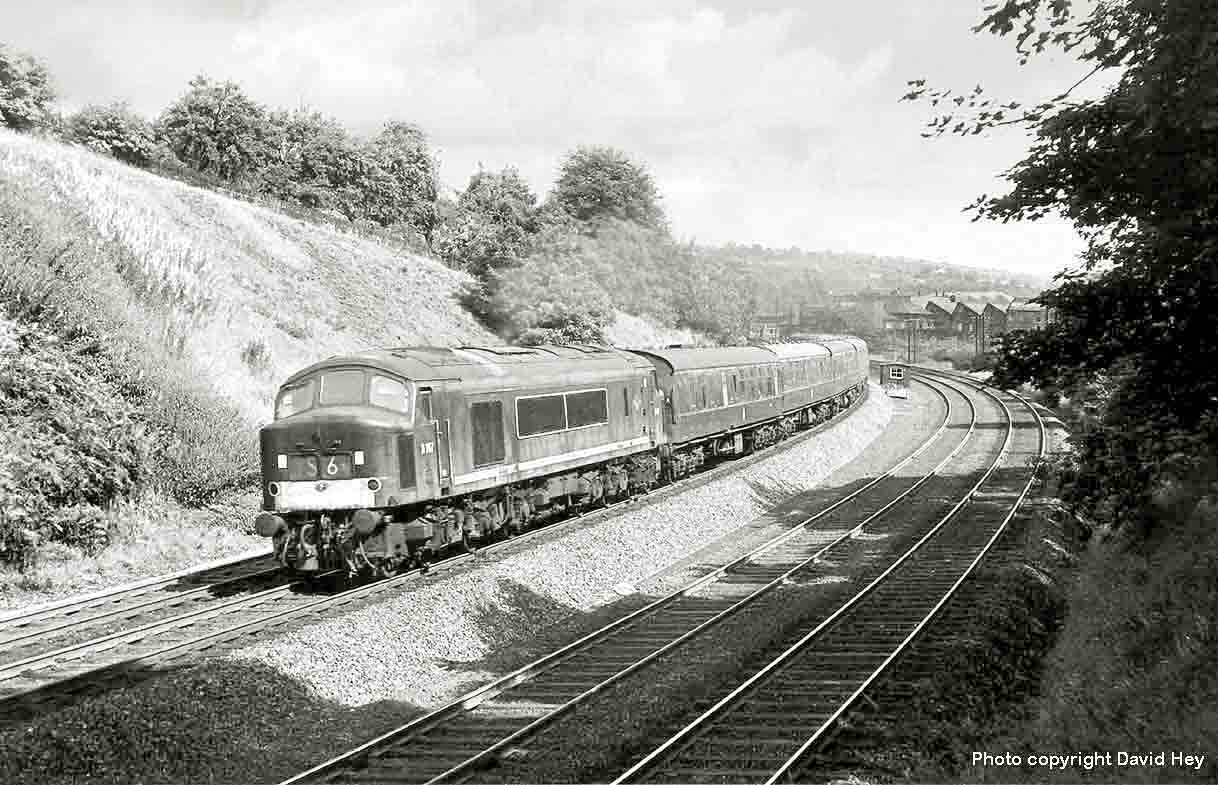

(Above-Below) Crewe Works was responsible for building Nos D50-D137 in the fleet of Class 45 'Peaks'. Here, the first of the batch, No D50 (later 45040) heads a uniform rake of Mk 1 coaching stock through Newlay Cutting in June 1964. The locomotive was named King's Shropshire Light Infantry in May the following year. Incidentally, I am unable to fathom out the identification of this train…the headcode display reads 2D 85, but the single headlamp mounted on the top lamp-iron might indicate a failure of the roller blinds. Note also that both locomotives are sporting the compulsory rectangular yellow warning panels on the nose-end, although their effectiveness is somewhat marred by the centre position of the four-character headcode panel which restricts its size to the lower half of the nose. (Below) The 183 production 'Peak' Type 4s were similar in appearance to the pilot scheme locomotives except for front end variations when the gangway doors and aged white headcode discs were abandoned in favour of divided headcode boxes - one each side of the nose on Nos D11-31 and D68-107 - and a two-piece or solid route indicator panel centrally placed on the remaining locomotives...the headcode displayed here is 1M86 southbound 'Thames-Clyde Express'. 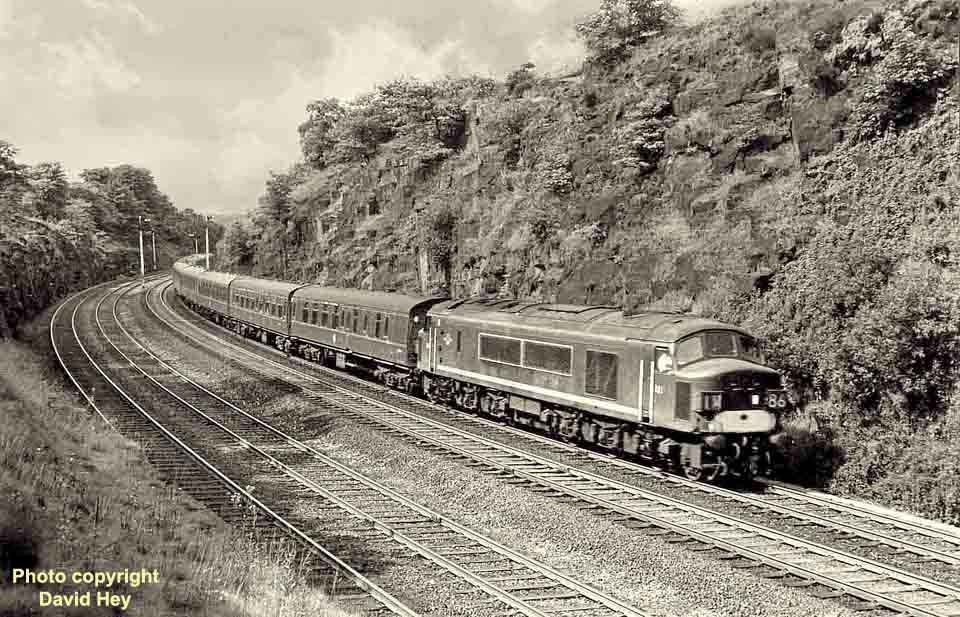
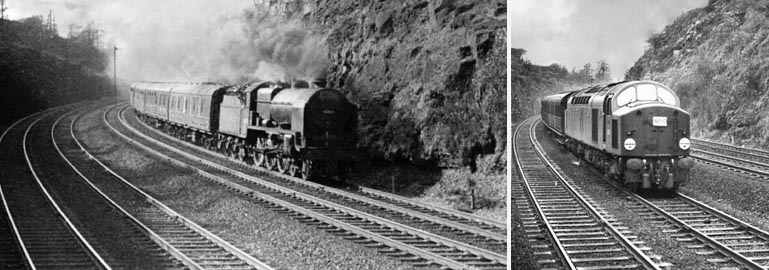
(Above Left-Right) The retaining wall in Newlay Cutting provided a perfect grandstand view of train in both directions and I spent many happy hours there with a camera. In these shots (above) a 'peg' on the 'up' slow line signalled the surprise appearance of Liverpool Bank Hall's 'Patriot' class No 45517 on the up 'Waverley' express (usually a 'Jubilee' turn) in April 1960, which was a rare 'cop' in my book. However, in that same year the writing was clearly on the wall for steam. Prior to the introduction of 'Peak' class Type 4 diesels on the Anglo-Scottish expresses north of Leeds, BR introduced an intensive crew training programme between Leeds and Appleby, involving train crewmen at Leeds Holbeck. Before diesel facilities were made available at Holbeck, a pair of BR Sulzer Type 4s Nos D11 and D14 were allocated temporarily to Leeds Neville Hill for the purpose. On occasions, however, an EE Co Type 4 power was borrowed for crew-training north of Leeds, such as York shed's No D252 seen here sporting a stencilled train reporting number N580 on its nose as it heads the return working to Leeds in October 1960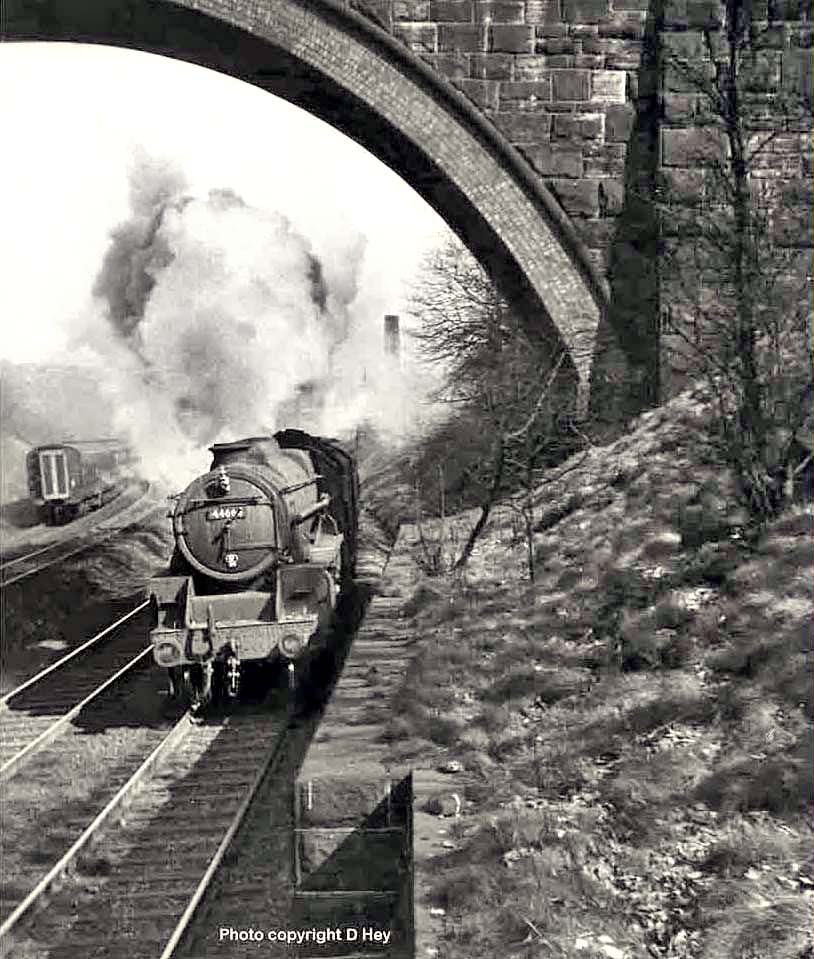
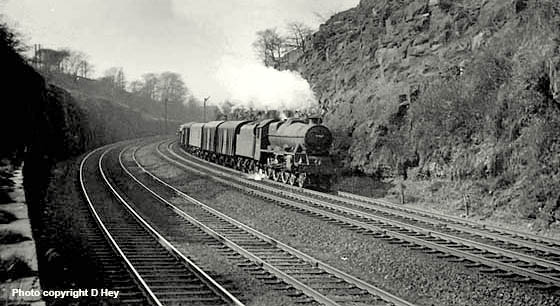

(Above-Below) An 'up' train headed by 'Jubilee' class No 45677 Beatty passes 2-6-4T No 42072 working an express from the south on the final leg between Leeds City and Bradford Forster Square. (Below) With the Aire Valley route now dequadrified between Leeds and Shipley, Class 47 No 47541 The Queen Mother heads the lightweight 16.10 Leeds-Carlisle through Newlay Cutting on 20th June 1983. The Queen Mother became the first member of the Royal Family to name a locomotive after herself at Aberdeen on Wednesday October 20th 1982. The nameplate was unveiled during a visit to the Granite City to attend a civic function. (Inset) Holbeck's 'Royal Scot' class No 46117 Welsh Guardsman storms through the cutting with the northbound 'Thames-Clyde Express' in March 1960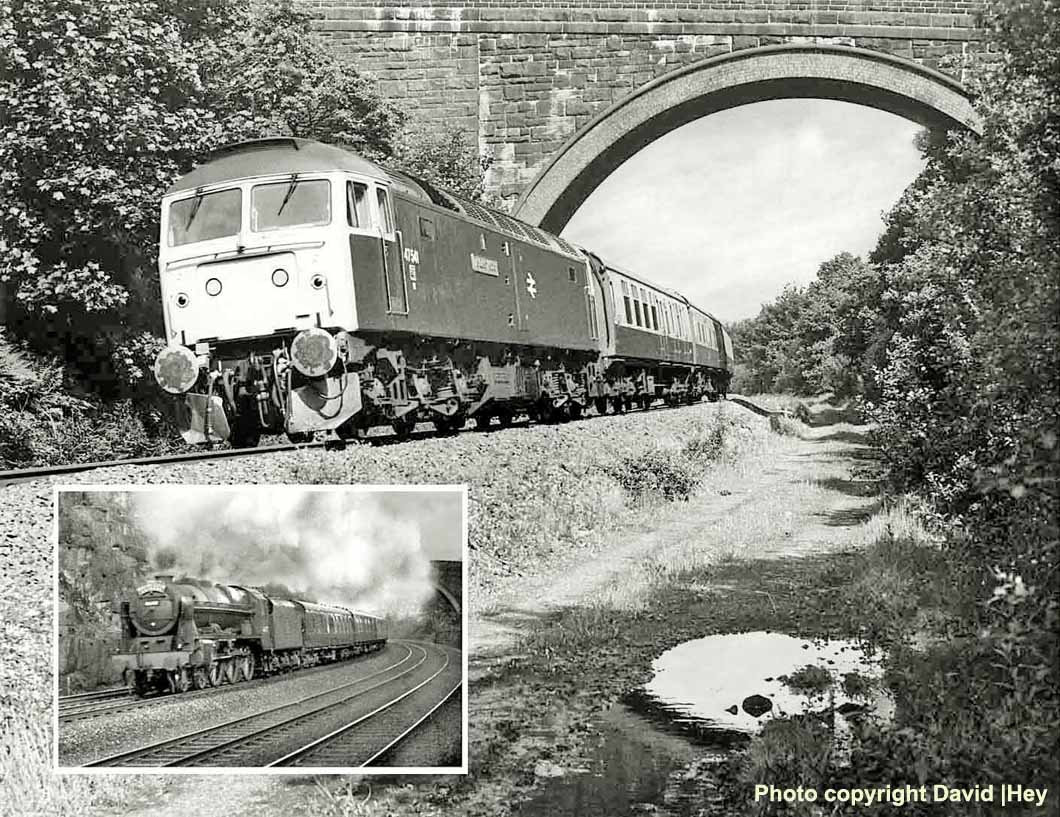
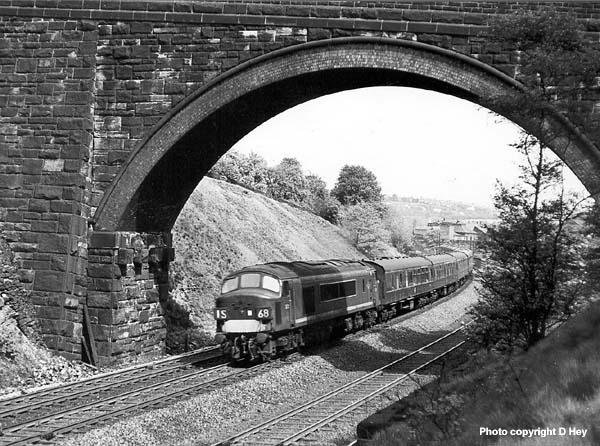
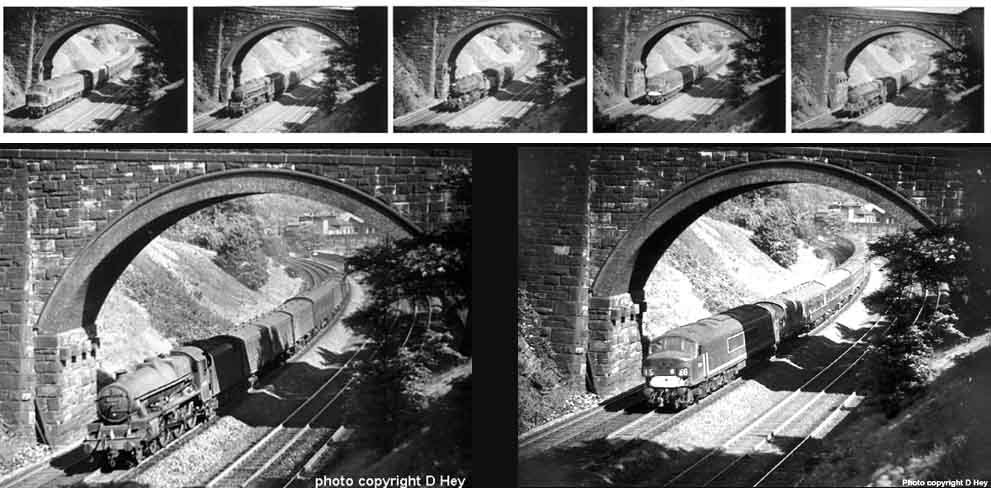
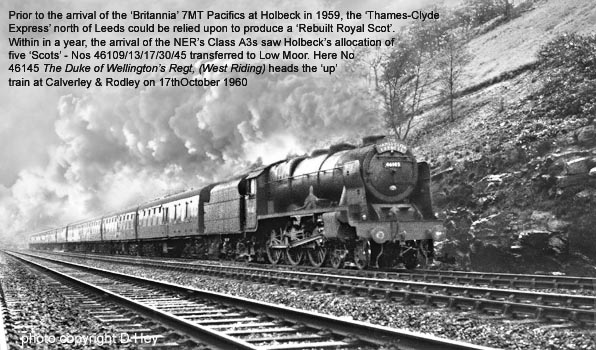
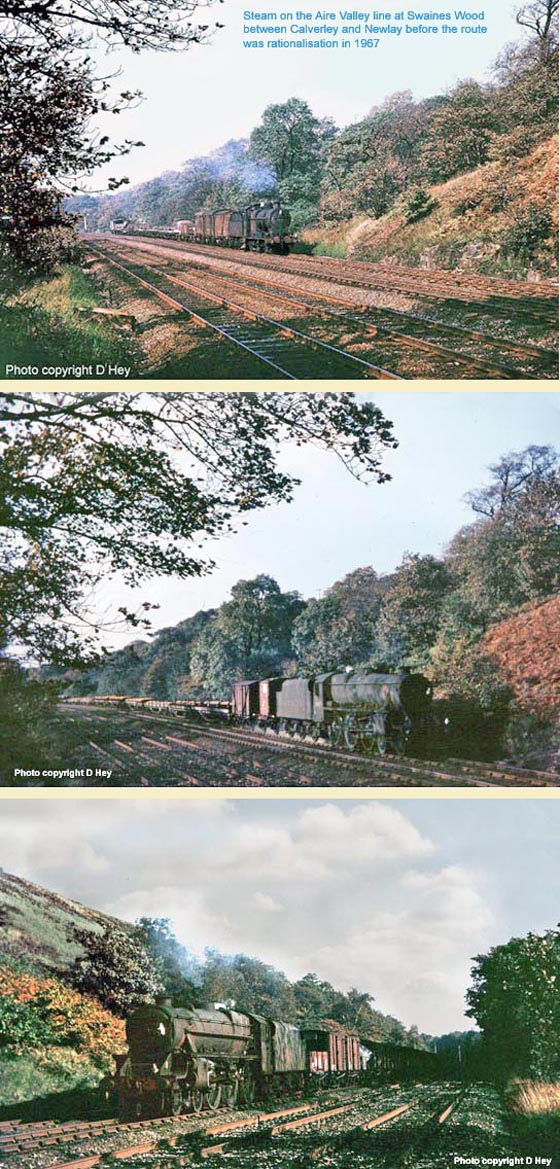
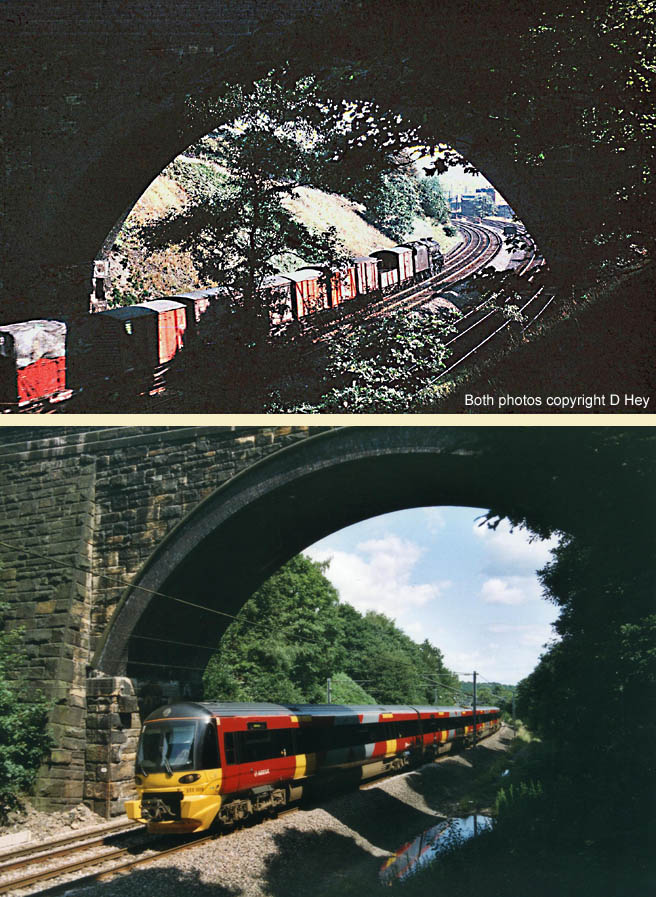
(Above) Now I'm getting older - engaged in an endless battle with middle-age spread - it's as if every wrinkle and every creaking joint is an offence against nature, rather than nature taking its course. Most men adopt 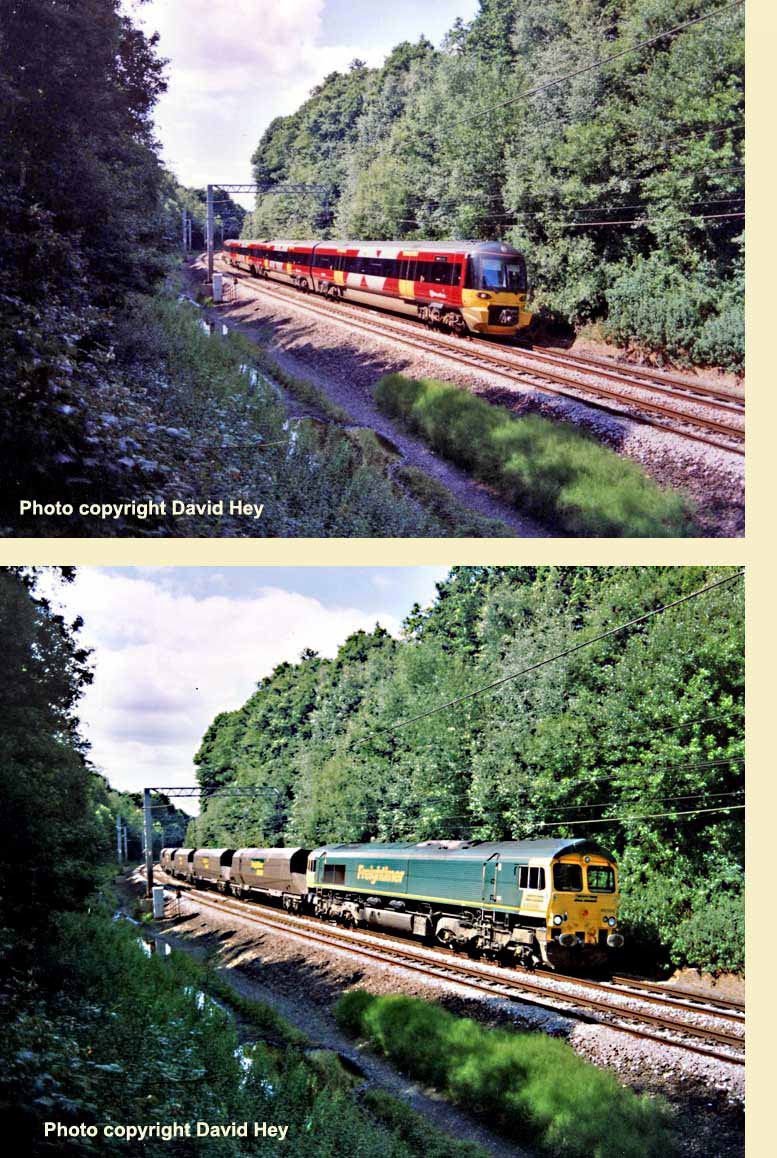 an uncomplaining acceptance of growing old - yet some men stubbornly refuse to give way to old age. Perhaps we haven't shaken off the rebellious streak we picked up during the 1960s? Whatever the reason, I can devise no rational explanation for clambering down steep railway embankments in search of places I visited as a teenager. After all, I was then in my prime - a cocky, self-assured reprobate who wasn't afraid to push the boundaries to see how far I could go. Nowadays it's carpet slippers by the fireside watching repeats of 'Dad's Army'. Still I did get the pictures I wanted with my trusty Canon A1, but I won't be going down there again in a hurry; the embankment is overgrown with trees and bushes, and the aging process catches up with everyone in the end! My back ached for weeks afterwards, however it was interesting to photograph the steady procession Class 66's pounding the track which is indicative of the resurgence in rail transport today.
an uncomplaining acceptance of growing old - yet some men stubbornly refuse to give way to old age. Perhaps we haven't shaken off the rebellious streak we picked up during the 1960s? Whatever the reason, I can devise no rational explanation for clambering down steep railway embankments in search of places I visited as a teenager. After all, I was then in my prime - a cocky, self-assured reprobate who wasn't afraid to push the boundaries to see how far I could go. Nowadays it's carpet slippers by the fireside watching repeats of 'Dad's Army'. Still I did get the pictures I wanted with my trusty Canon A1, but I won't be going down there again in a hurry; the embankment is overgrown with trees and bushes, and the aging process catches up with everyone in the end! My back ached for weeks afterwards, however it was interesting to photograph the steady procession Class 66's pounding the track which is indicative of the resurgence in rail transport today.
(Inset) Introduced in 1978, the Canon A1 was the first SLR to offer an optional electronically controlled auto-exposure mode; hence you could either a lens aperture f-stop or a shutter speed to take a photo and the camera automatically 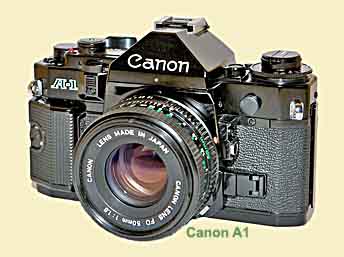 calculated the exposure; it was years ahead of the competition and the 1,0000sec shutter was ideal for railway photography. Alas it came too late for photographing steam days, but it has produced some good results when photographing diesels in the 1980s. In many way these are just as interesting because much of our railway heritage was swept away by post-60s rationalisation of the network.
calculated the exposure; it was years ahead of the competition and the 1,0000sec shutter was ideal for railway photography. Alas it came too late for photographing steam days, but it has produced some good results when photographing diesels in the 1980s. In many way these are just as interesting because much of our railway heritage was swept away by post-60s rationalisation of the network. 

(Above-Below) But getting back to spotting days, long before air-tight plastic food containers (Tupperware) was invented, an ex-Army & Navy shoulder bag was an essential accessory for spotting trips. It contained jam butties the size of breeze blocks, 'fizzy' pop, an Ian Allan abc and notebook and, above all else, a Kodak Brownie 127 camera (buried beneath half a bag of Jammy Dodger biscuit crumbs). The camera had a shutter speed of 1/25 second and was the cheapest way of getting started in railway photography, but the temptation to fill the viewfinder with a speeding locomotives (to the exclusion of everything else in the surroundings) inevitably ended up with a set of blurred shots. It wasn't until my dad suggested taking a step back from the action and embracing more of the railway scene that things improved - and thank goodness I heeded his advice (most of the time) because the railway network has changed out of all recognition over the years and the general view often produces a more interesting picture. In this shot (above) a 'Black 5' heads a 'down' train beneath the A6120 Ring Road whilst (below) a Midland Compound No 41121 heads a Leeds City-Bradford Forster Square local train in July 1958.


(Above) An example of the Government's misplaced enthusiasm for station closures is Calverley & Rodley station - one of seven stations which lost its passenger services between Leeds, Bradford, Ilkley and Skipton in March 1965.
Had only the station survived, then the newly-formed Passenger Transport Executive - implemented in 1974 to integrate local road and rail passenger services in the Metropolitan County of West Yorkshire - could have adopted this site as a 'park and ride' facility for Leeds and Bradford commuters.
Just imagine the benefits! The station is situated less than a quarter of a mile from the heavily congested A6120 Leeds Ring Road...a wonderful opportunity missed!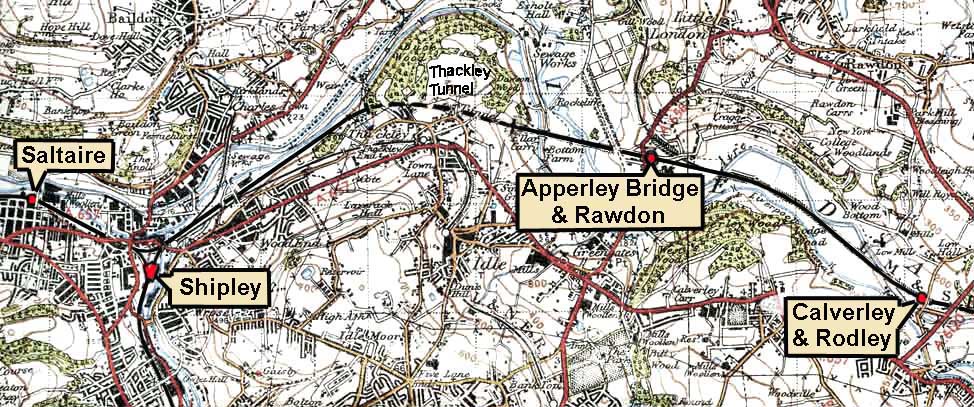
But setting aside political shenanigans for one minute (I've done enough beefing about Beeching elsewhere on this site!) this page is basically a gallery of photos dating back to the early Sixties when steam was still King and diesels had yet to make major inroads.
Indeed no matter how long ago it all now seems, the memory we have of childhood spotting days in the Fifties will never go away. The same can be said for the fun-loving 'Swinging Sixties', albeit the decade was also marred by sadness. The certain knowledge that BR steam was about to disappear from our lives cast a gloomy resonance over the spotting fraternity…worse still, Dr Richard Beeching was about to slash the rail network to a shadow of its former self. The publication of his 'Reshaping of British Railways' in 1963, had one aim in mind - to make our railways pay, but his idiotic plan for full-blown closures was not the only solution. Had only he waited until the introduction of pay trains, modern signalling and unmanned stations, then he'd have identified many areas where huge reductions in operating costs could be made. This surely would have merited the retention of many rail services, particularly those serving heavily populated towns in the West Riding including the Aire Valley between Leeds and Skipton.
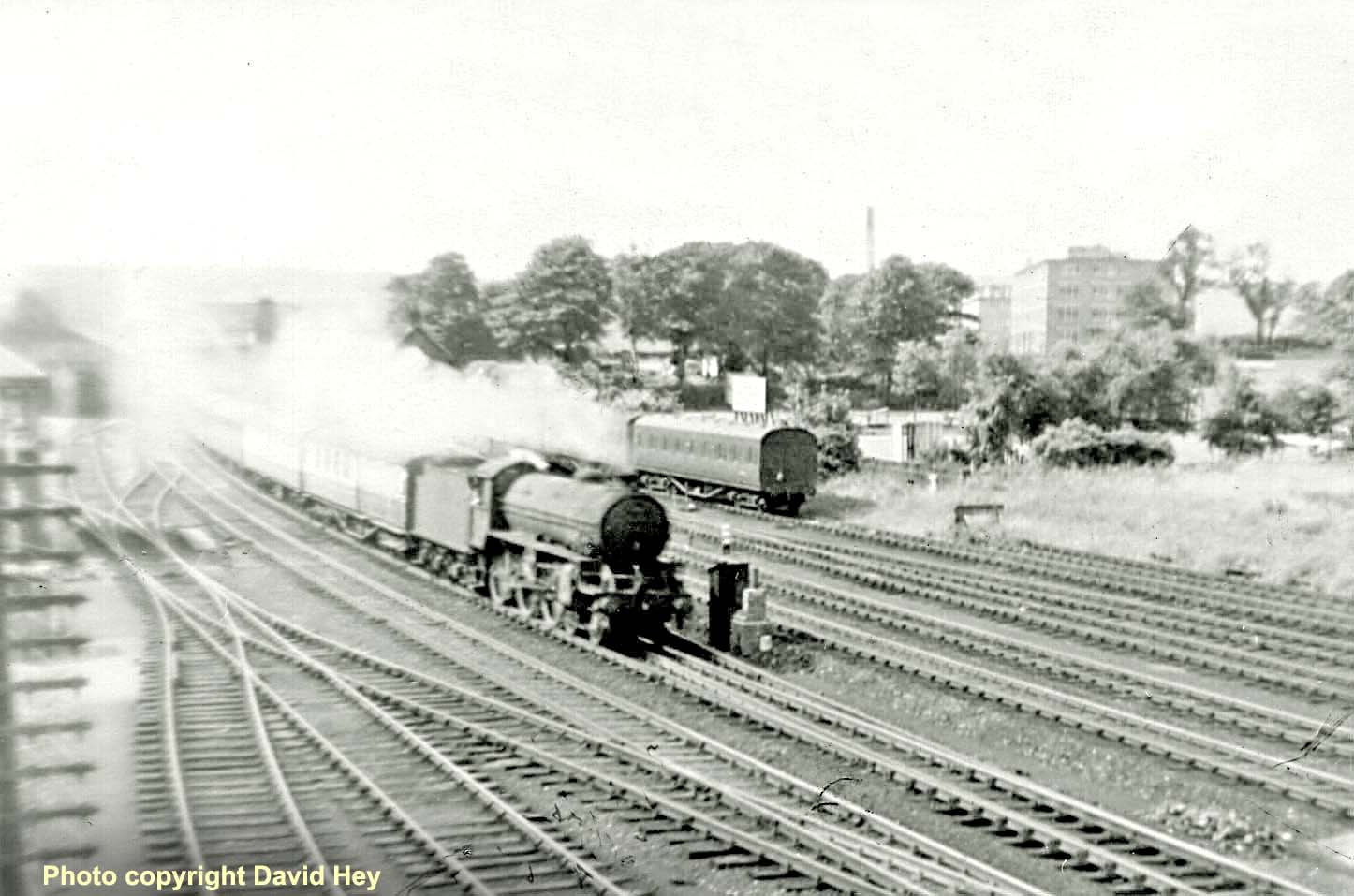
(Above) The childhood memory is fallible, they say, but if I had to take stock of all my spotting memories, the sight of a mid-afternoon express thundering through Calverley & Rodley behind a rockin'-rollin' Class B1 is the most profound of all. Talk about rough-riding! It was a spell-binding moment that rooted me to the spot. The train hurtled through the station, rocking and swaying over the points like a wild stallion. You could feel the air pressure bearing down, a headlong rush of noise and smell - then it was gone, the magic all too brief. I'm not sure if the NER driver had some misbegotten allegiance to former companies engines working on MR territory, or if the train was booked to an impossibly tight mid-afternoon schedule between Bradford and Leeds. Whatever the reason, thanks for the memory! (Below) Minutes later 'Jubilee' class No 45694 Bellerophon put in an appearance on an 'up' express. Both photos were taken on a Brownie 127 in June 1958.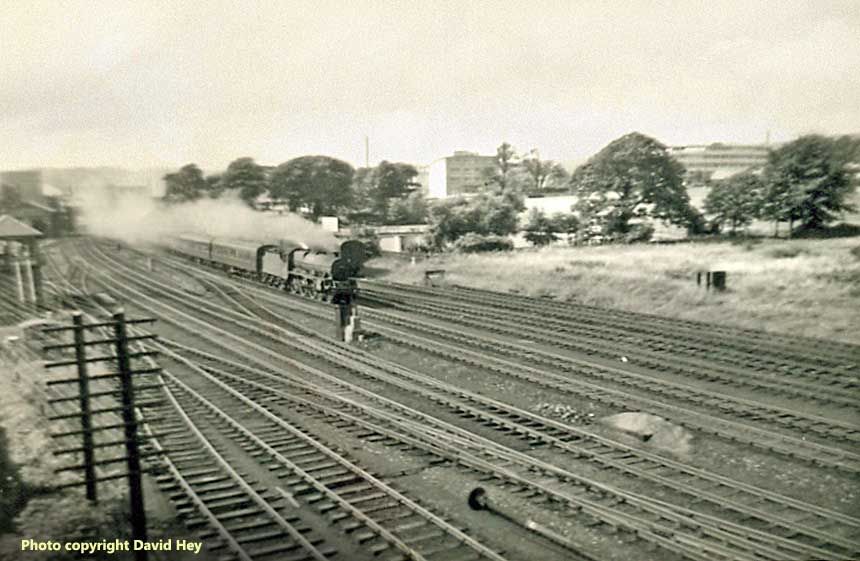
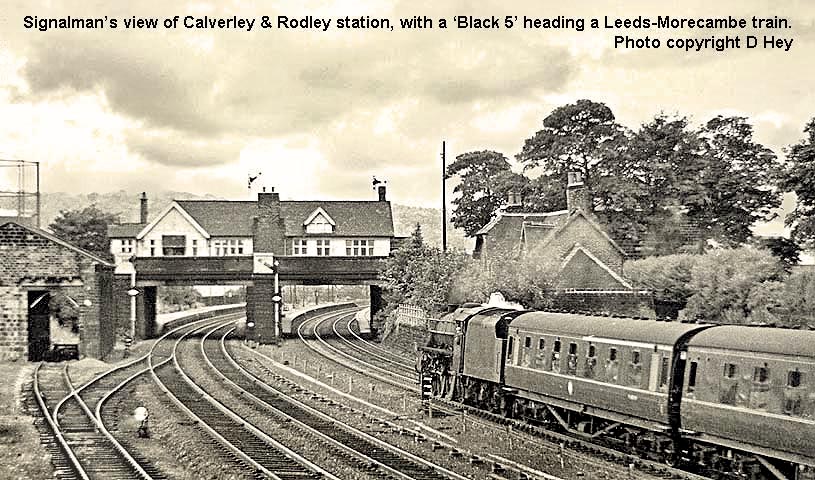

(Above-Below) I'd like to say that this is a perfectly executed 'panning' shot. It isn't...it's an accident! All I did was point the camera and the Brownie's chronically-slow 1/25sec shutter speed captured the ambling pace of a Class 8F heading an 'up' freight through Calverley and Rodley...nevertheless, a wee-bit of 'tidying up' in Adobe Photoshop was necessary in order to straightened out most of the track in the foreground. (Below) Alas no amount of tidying-up in Photoshop can improve this grainy shots of a Class 8F trundling through Calverley with an 'up' freight...virtually everything you see in this picture has disappeared: the gasworks, railway station, sidings, signal box and now the Sandoz factory have long since gone, and all that remains are the 'up' and 'down' lines (formerly the 'slow' lines). 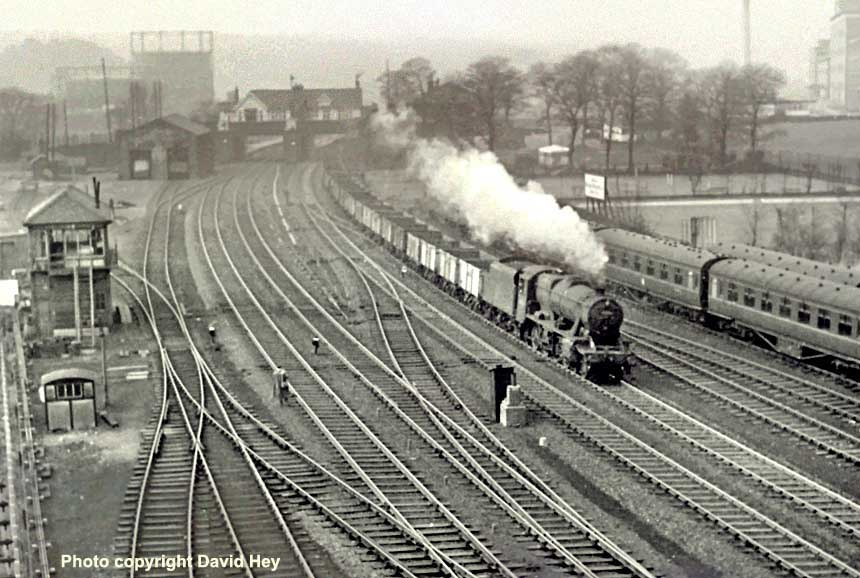
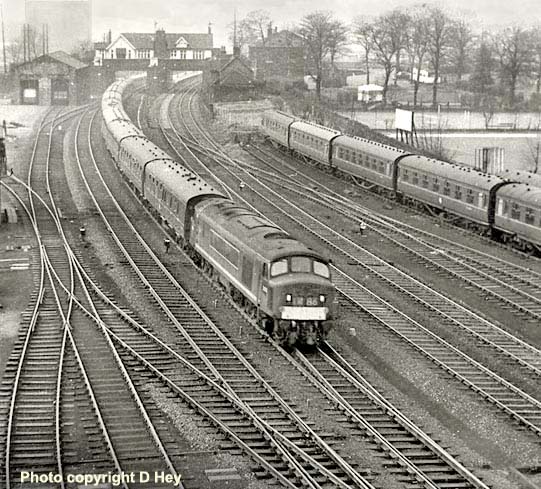
(Above) This unidentified 'Peak' class (sporting 1M86 in its headcode display panel denoting southbound 'Thames-Clyde Express') was taken on the same drab, miserable day as the 8F. British Railways introduced the new train identification system in 1961. The headcode panels consisted of a four-character letter and numeral display; the first number identifying the class of train, followed by a letter indicating the destination, whilst the next two digits represented the train reporting number. For example, the Peak's headcode begins with a '1' denoting an express passenger train, the 'M' identifies the Midland Region and the '86' refers to the train reporting number. For the record, the northbound 'Thames-Clyde Express' displayed 1S68 (the 'S' denoting the Scottish Region). Over the years, it was found that vibrations caused the numbers to revolve on their own accord, and the varying non-descriptive digits often displayed was a major factor for BR's decision to dispense with headcodes entirely. From 1976, the operating handles were removed and blinds set permanently at '0000', then during classified overhauls at Works the distinctive four-character headcode boxes were removed and two fixed-beam lamps were fitted.
(Below) This shot of 'Peak' class D79 (later Class 45/0 45005) heading the 'down' 'Thames-Clyde Express', was taken from beneath the signal box. Note the three bodyside steps immediately behind D79's leading cab. The introduction of modern coaching stock fitted with ETH (electric train heating) led to the removal of the redundant steam-heat boilers. At the same time the water filling points were removed from cantrail height and the 3 bodyside steps plated over. This was to prevent crewmen climbing up to roof level in areas with overhead electrification equipment. 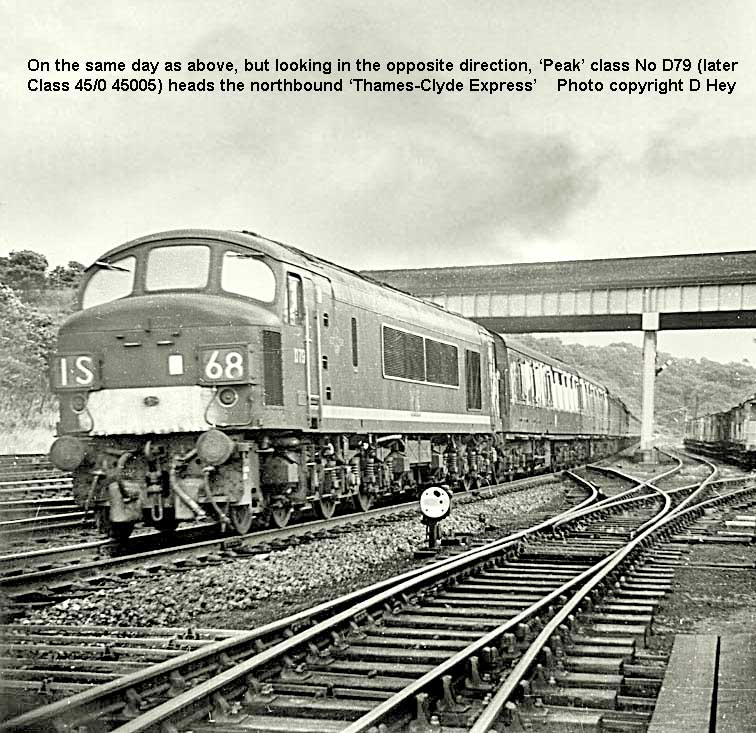
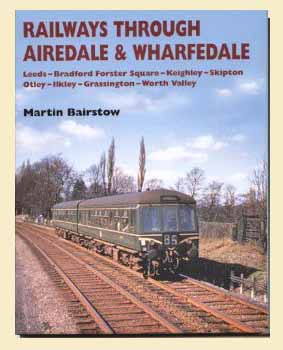 (Inset Right) A page on the Aire Valley Line would not be complete without mentioning Martin Bairstow's excellent series of railway books, including 'Railways Through Airedale & Wharfedale' (right). Click on image to find out more.
(Inset Right) A page on the Aire Valley Line would not be complete without mentioning Martin Bairstow's excellent series of railway books, including 'Railways Through Airedale & Wharfedale' (right). Click on image to find out more.
(Below Left) The Aire Valley Rail Users Group (AVRUG) campaigns tirelessly to support today's rail passengers using the Aire Valley Line and the routes from Airedale to Carlisle, Morecambe and London. To ensure that rail passengers enjoy the best possible train services and station facilities, the Group has a close relationship with other rail user groups concerned with the promotion of a quality public transport.
Click on image (below) to visit the AVRUG's website. It's always great to receive emails relating to train spotting days for inclusion on the website, no matter how big or small.
It's always great to receive emails relating to train spotting days for inclusion on the website, no matter how big or small.
My thanks to Paul Hogarth for dropping a line.
He writes - 'Hello David, just a quick note to say thanks for the images of Calverley and Rodley Station. I was born in Rodley and spent many hours spotting on the embankment by the Ring Road. When I was young and at Sunday School (a long time ago!) one of the  chapel stalwarts was Tom Harrison who was signalman (and quite deaf) at the box shown, and a few of us had the privilege of spending a half-day in the active box. Oh those uncomplicated days! I remember the Royal coaches being held overnight in the sidings opposite the signal box, probably in the mid-1950s, so it could have been a young Queen Elizabeth.
chapel stalwarts was Tom Harrison who was signalman (and quite deaf) at the box shown, and a few of us had the privilege of spending a half-day in the active box. Oh those uncomplicated days! I remember the Royal coaches being held overnight in the sidings opposite the signal box, probably in the mid-1950s, so it could have been a young Queen Elizabeth.
I found your images whilst trying to find some photos of the Calverley Bridge gasworks - the same one you used to get some of your photos! Great, thanks for the memories, Paul Hogarth...'
Thanks Paul, I've found another shot of the gasworks; it's not very good, a random shot rattled off to expose the first frame of a new film. 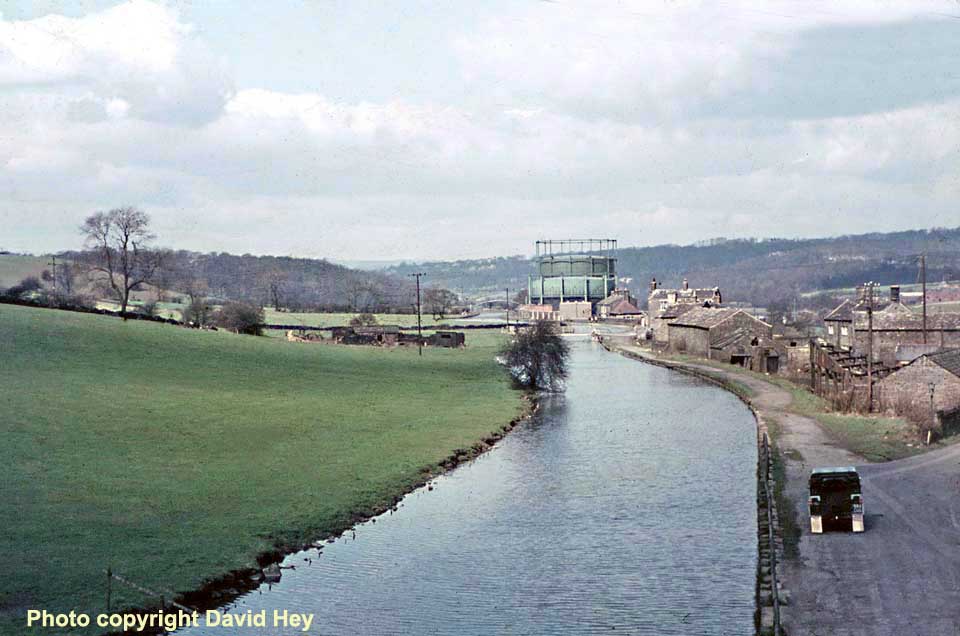
(Above-Below) It's amazing the lengths to which some photographers will go to bag that all illusive 'master' shot! I've seen cameramen shinny up signal posts, climb onto roofs and hang perilously from trees. But then, I'm as guilty as the next man, which is the reason I've included this shot of the Leeds-Liverpool canal at Calverley and Rodley in 1962. It shows the now-demolished gasometer, which, at its full height, provided a panoramic view of the Aire Valley line in both directions. I don't know what lunatic tendency told me that I'd get a great shot of the railway if I climbed to the top, but I did...I sat there in full view of the public like a prized-lemon - there's no place to hide on top of a gasometer! Still I managed to bag these shots of a Black 5 heading across the River Aire towards Leeds with an engineers train...look closely at the piers supporting the bridge, the eagle-eyed might spot the clutter of debris swept down the river. 
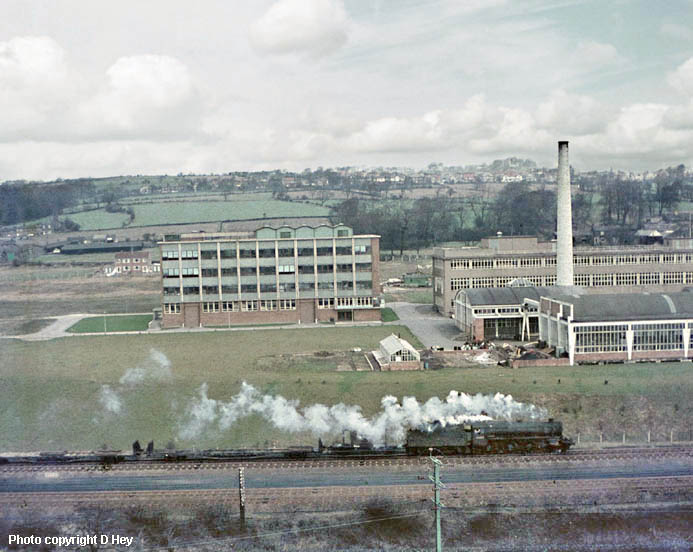
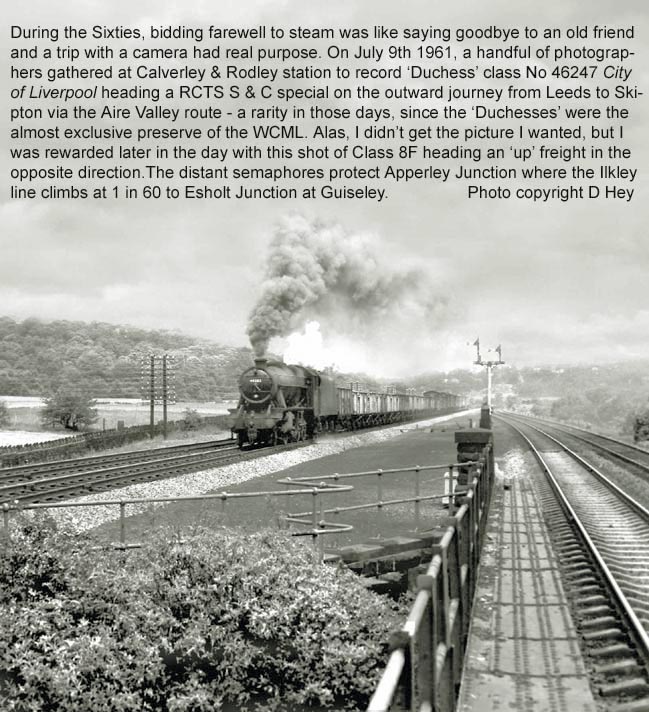
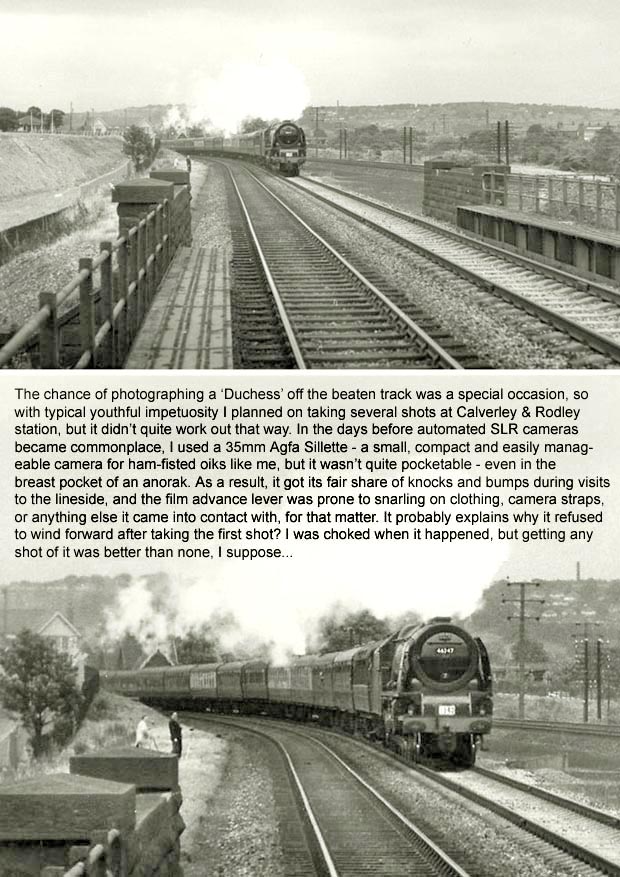
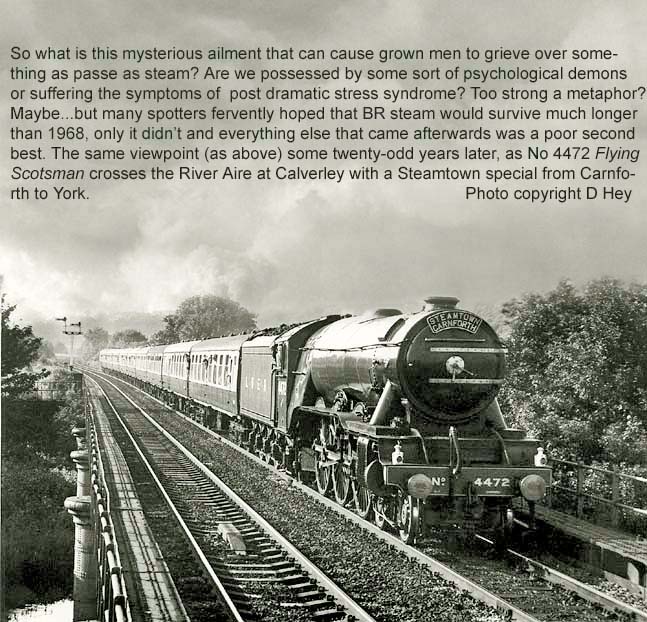
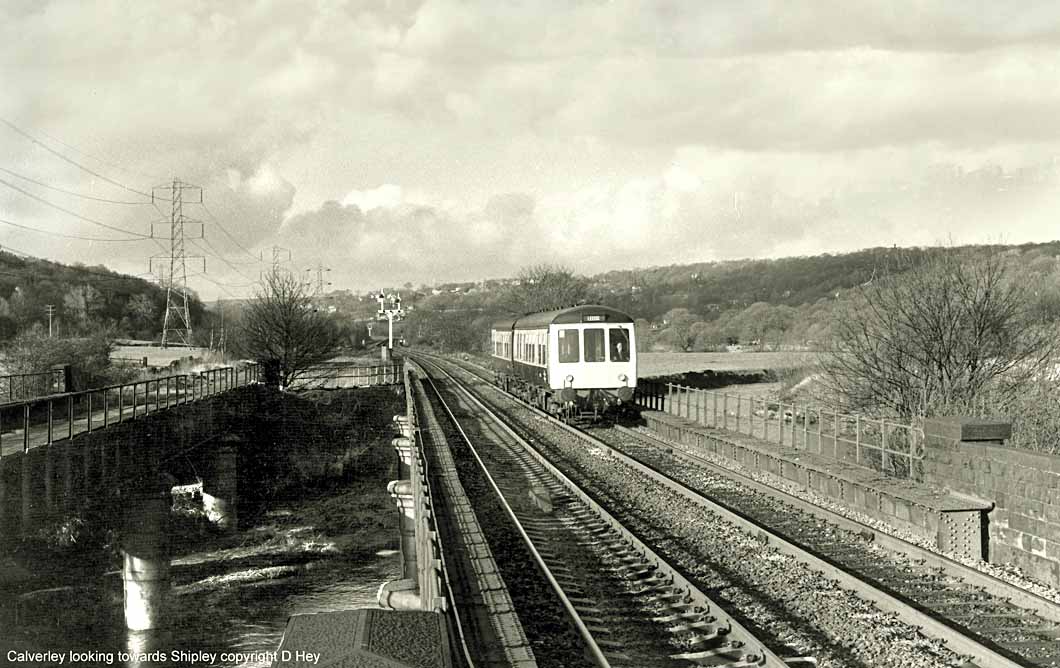
(Above-Below) Following reduction of the route to two lines, the abandoned trackbed is still conspicuous today, particularly on bridges where the line crosses the River Aire and Leeds & Liverpool Canal; this is very noticeable during the winter months when the tree foliage is less dense. (Below) Close up of the splitting distant; the lower semaphore denotes a Leeds-Ilkley service is due. 
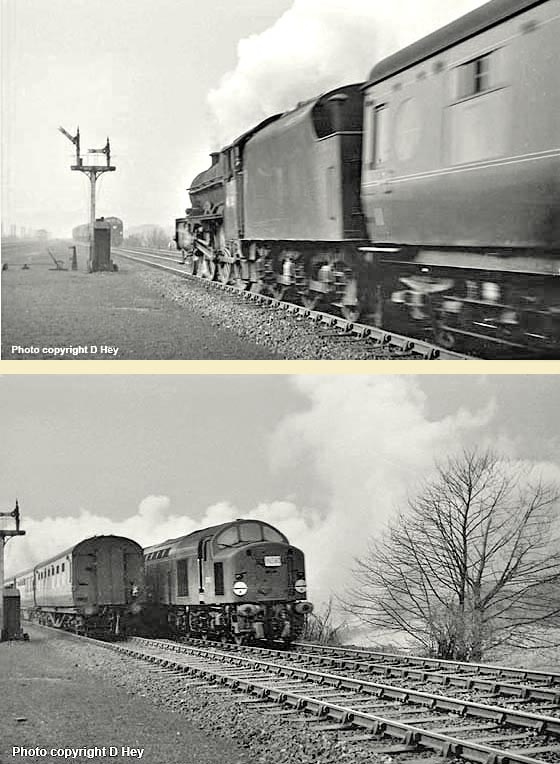
(Above) Caught on the hop! Before the introduction of Type 4 'Peak' diesels at the start of the 1961 summer timetable, diesel locomotives were something of a novelty on the Aire Valley line north of Leeds, so when I saw an approaching EE Co Type heading my way it was a rare chance to photograph something different. But as you can see this northbound 'Jubilee' had other ideas! It is early March and BR had just started a crew training programme between Leeds and Appleby involving footplate staff at Leeds Holbeck. The train of empty coaching stock (N580) departed from Neville Hill at 9.30am - arriving at Appleby at 11.43 - returning at 12.55 for the trip back to Leeds. The Type 4 is seen here sporting a stencilled train reporting number N580 on its nose as it heads the return working to Leeds. 
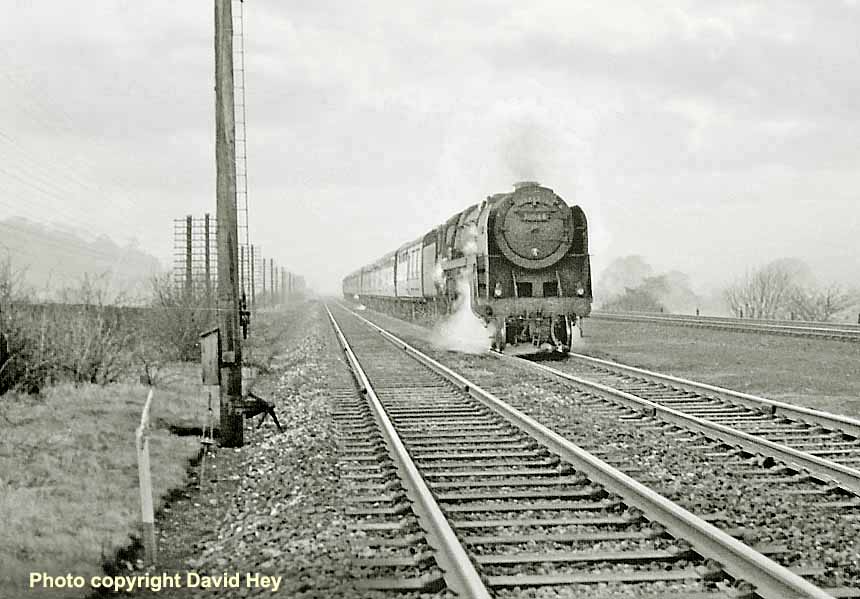
(Above-Below) The following photos are conventional three-quarter lineside shots of the stretch of line between Calverley and Apperley Bridge Junction, illustrating the photogenic quality of steam in the landscape compared to that of soulless diesels...
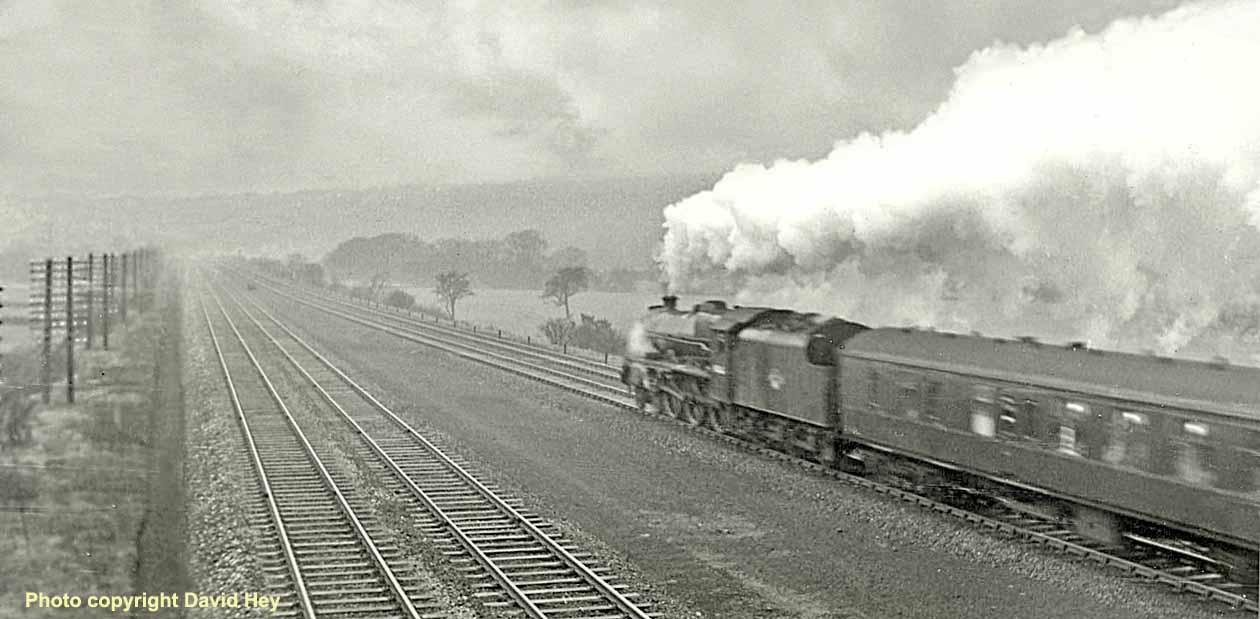
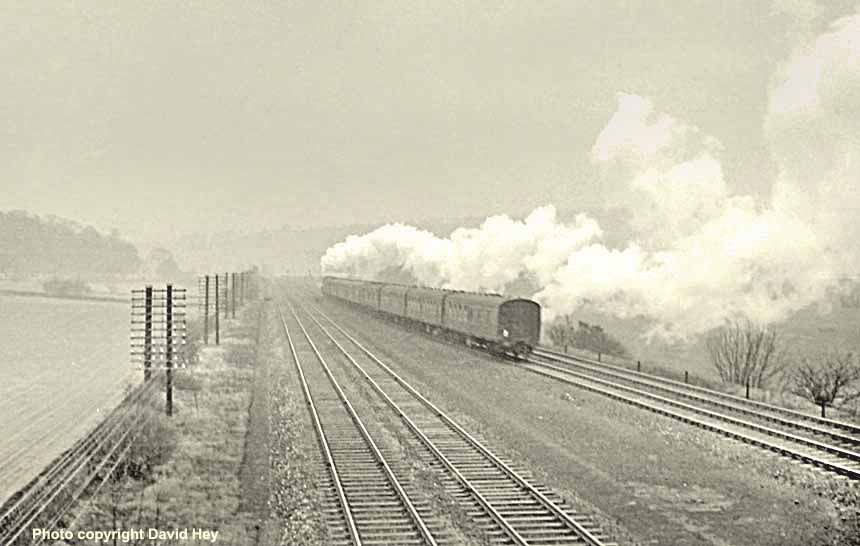
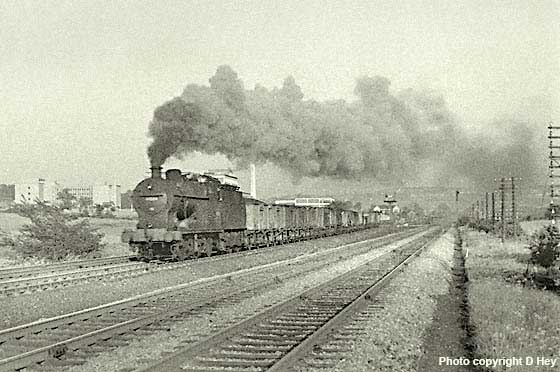


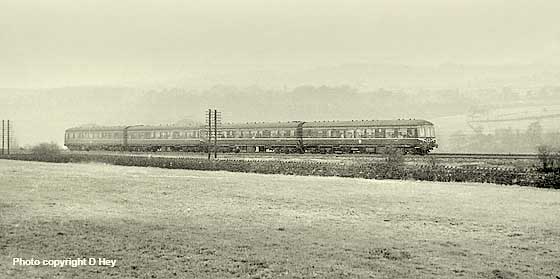
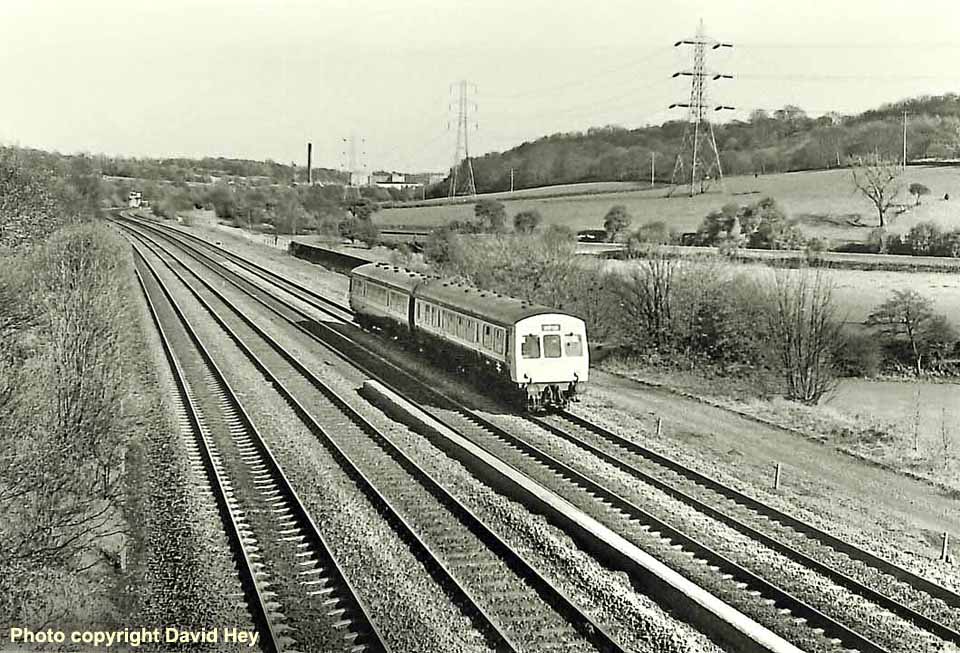
(Above-Below) The following photos are conventional three-quarter lineside shots taken at the divergence of the Ilkley line at Apperley Bridge Junction in the early 1980s. As a prelude to the installation of 25kV overhead wires between Leeds, Bradford, Ilkley and Skipton, work began on replacing the Aire Valley Line's traditional mechanical signalling in 1994; several sections of track were extensively remodelled (singled) and all signal boxes and associated semaphores along the route were replaced by modern colour light signals operated from the existing 1967 power box at Leeds. The signal box at Apperley Junction controlled the divergence of the line to Ilkley which climbs at 1 in 60 from the valley floor to Guiseley. Built by the LMS in 1927, the now-demolished box can be seen in the distance as a 2-car Metro-Cammell unit approaches with a Leeds-Skipton service; the train is passing over the viaduct across the River Aire which is just visible in the right foreground. The course of the Leeds-Liverpool Canal can be traced by the line of trees in the mid-distance. (Below) The track layout in the previous photo is something of an optical illusion; it appears as if the line is quadrupled. This panoramic view gives a much better angle and shows a Leeds-Ilkley dmu at the start of the climb to Guiseley. 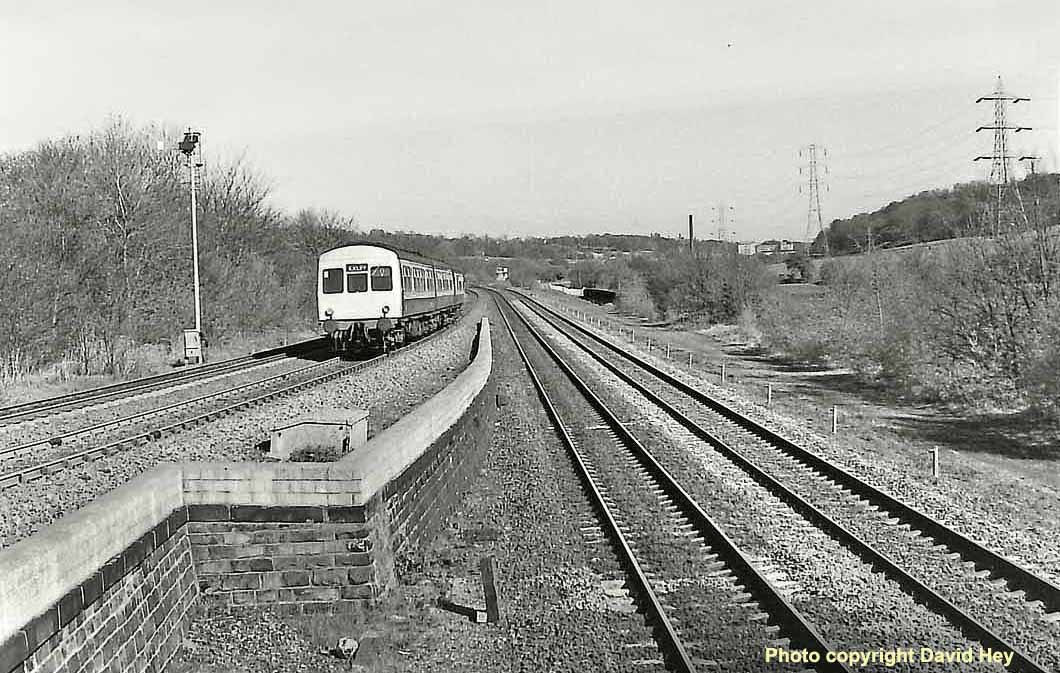
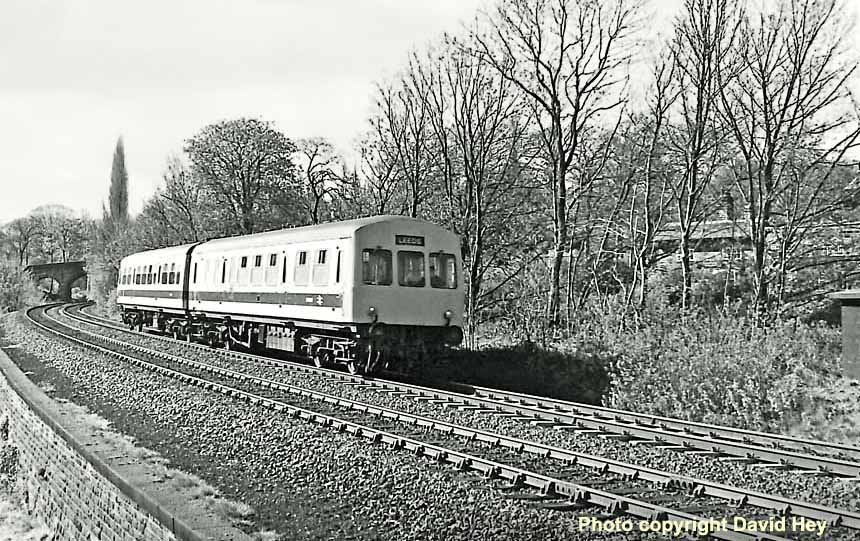
(Above-Below) In the opposite direction a recently refurbished 2-car Metro-Cammell unit rattles down the hill on the Ilkley-Leeds service. (Below) When these photos were taken in the early 1980s the introduction of the second-generation dmus (Class 14X 'Pacer' and Class 15X 'Sprinter' types) were still some way off and the backbone for local passenger services continued to be provided by elderly Metro Cammell dmus and Derby Class 108 units; the latter can be seen in this shot of a Leeds-Bradford 2-car set approaching Apperley Bridge. The picture beneath it shows the view in the opposite direction; the Tilcon train (6505) to Hull is being held at signals...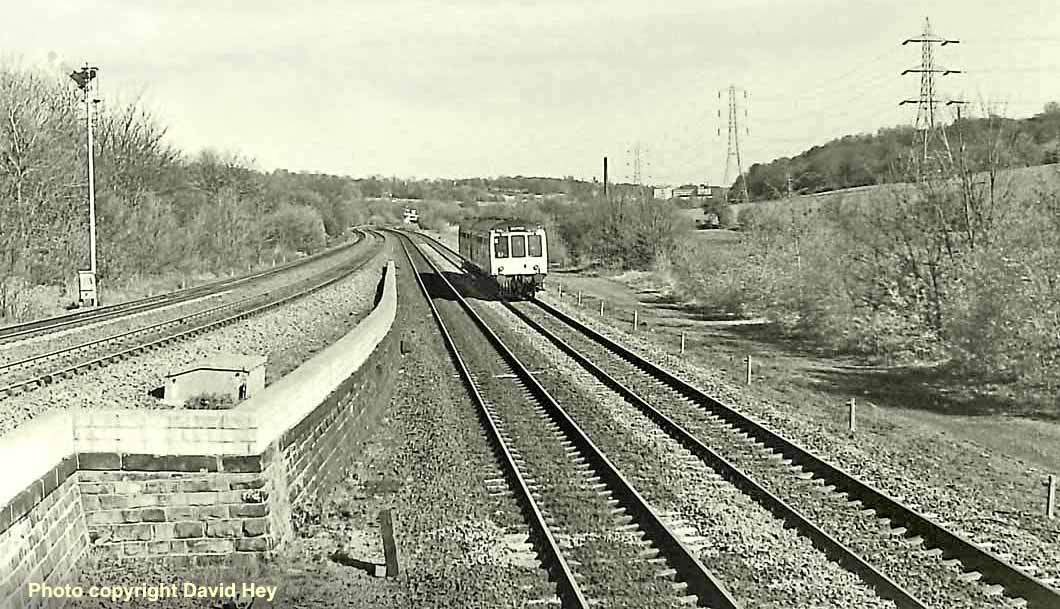
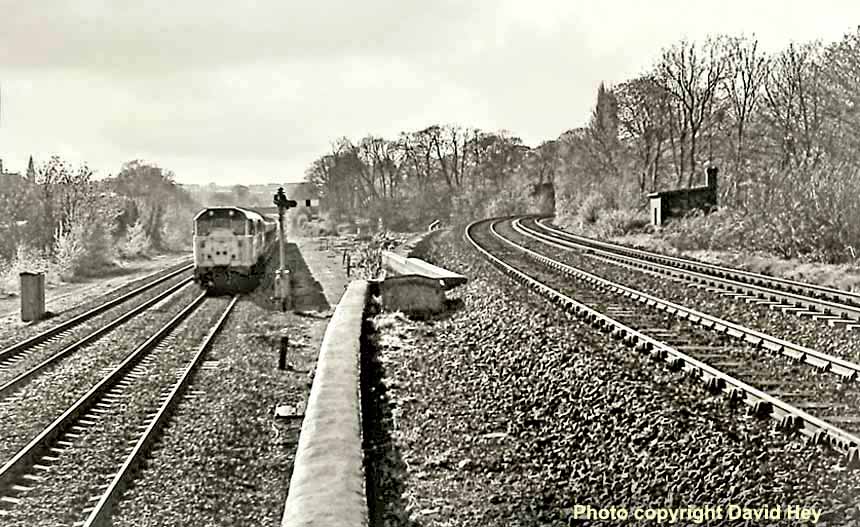
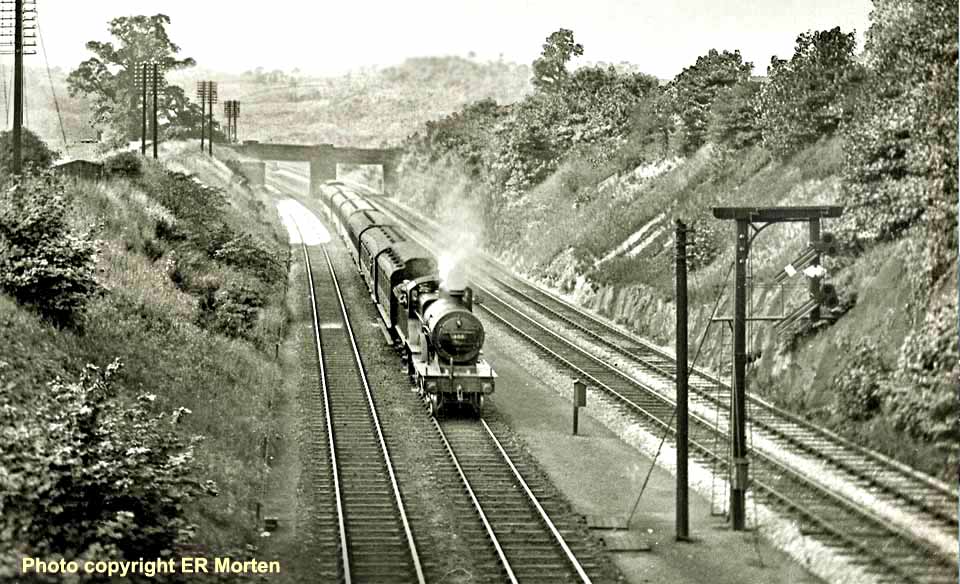
(Above) A classic ER Morten shot of Apperley Bridge during MR days in 1932; a Class 2P Compound heads a rake of elderly MR coaches, including clerestory stock, past the site of the new Apperley Bridge station. Click here HERE to visit Wikipedia.org which contains links to various sites on the project. 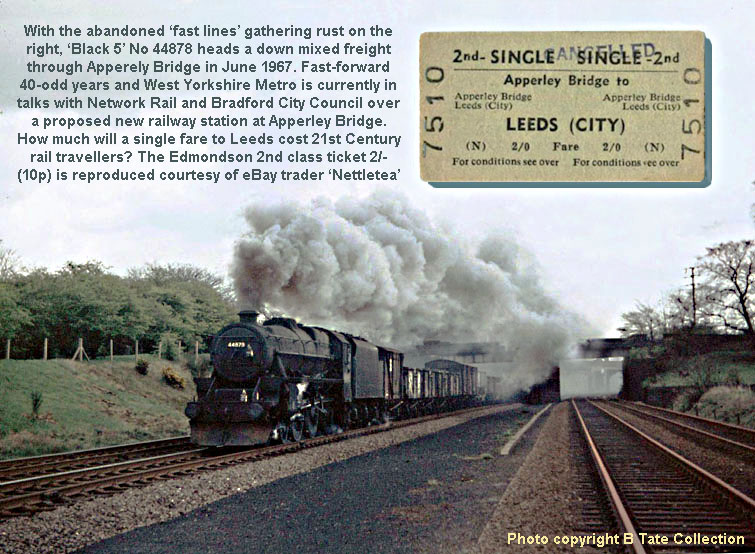
(Above-Below) This colour shot was first posted in 2009...the answer to the question regarding the cost of a single fare from Apperley Bridge to Leeds is £3.60. (Below) In 1952 Mister Morten was back again - railway photographers are known to be creatures of habit! This fine study shows Class 8F No 48149 storming through Apperley Bridge & Rawdon station with a 'down' freight on 19th April 1952. The Ilkley line can be seen climbing at 1 in 60 to Esholt Junction beyond the lamp post in the left background. 
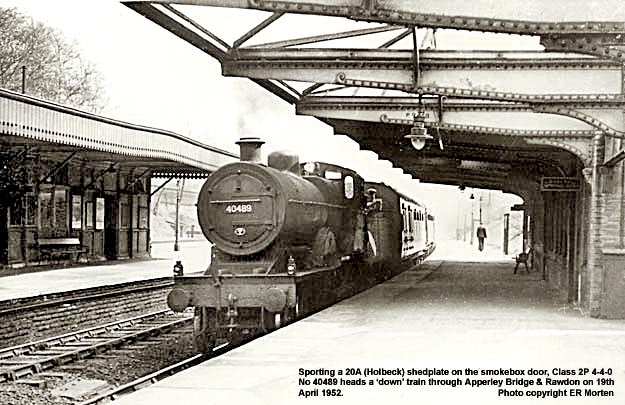
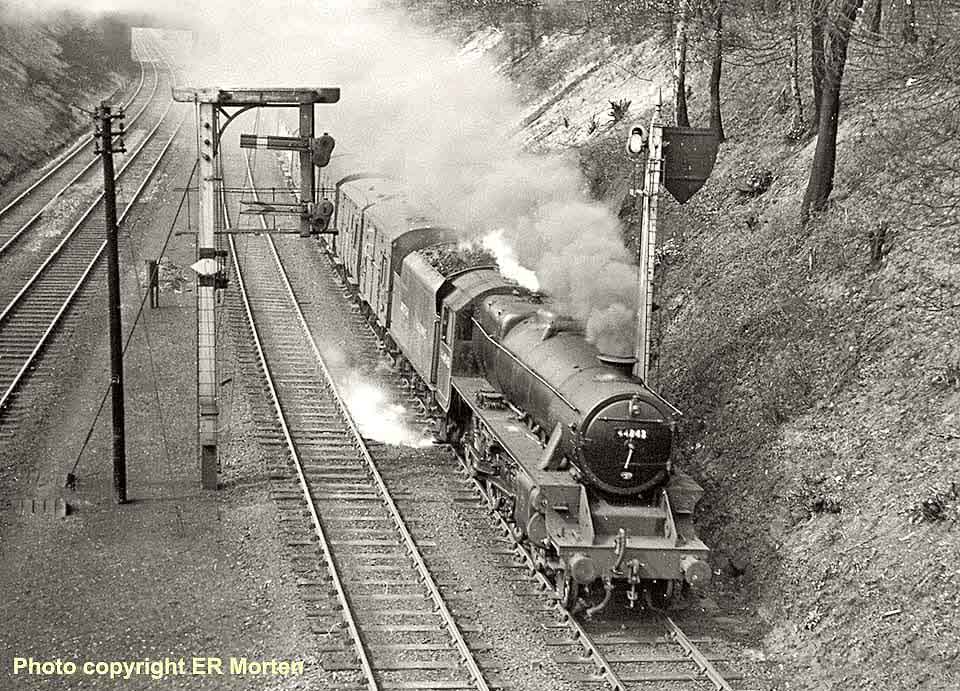
(Above-Below) Flanked by ex-MR lower quadrant semaphores, 'Black 5' No 44843 heads a Morecambe-Leeds train at Apperley Bridge & Rawdon on 19th April 1952. (Below) In the opposite direction, No 45230 makes heavy work of a 'down' coal train in September 1962.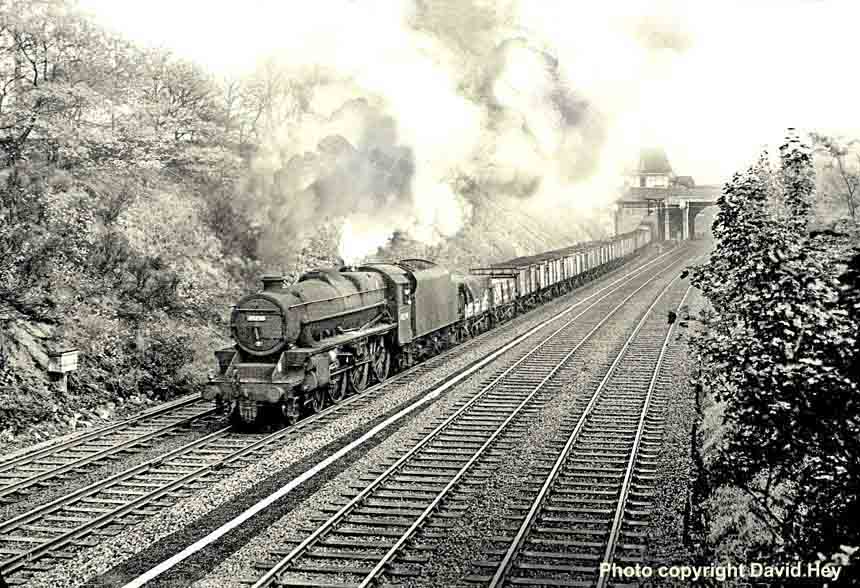
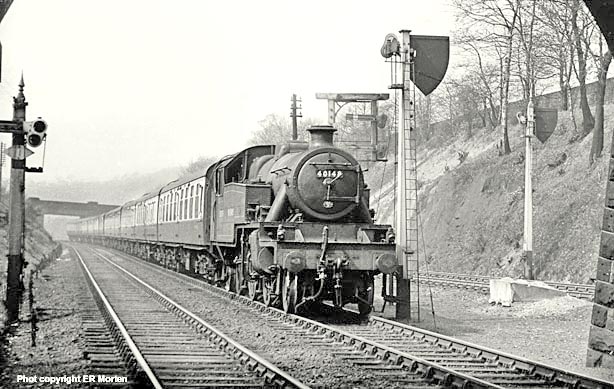
(Above) Stanier 2-6-4T No 40148 - one of five members of the class rebuilt in 1941 with a larger boiler - heads the Bradford portion of a London St Pancras train towards Leeds on 19th April 1952. (Below) BR 'Britannia' Class 7MT 70039 Sir Christopher Wren charges through Apperley Bridge with a northbound steel plate train on the evening of 18 July 1964. Photographer Peter Thorpe (check out his 'Rail Cameraman Page 63 HERE) remembers the moment well. From his position on the wall leading down to the station's goods yard, he could see the smoke of approaching down trains passing Apperley Junction just beyond the bend in the distance and he noted how exceptionally fast this particular train was moving. Over the years he had observed everything from Gresley A3s, 'Scots' and 'Jubes' through to Type 4 'Peaks' working express trains at Apperley Bridge, but this was by far the fastest he had ever seen on that stretch of line. A Brit! Setting the shutter speed to 1/500sec and a wide aperture at f2.8, the comment he noted in his book - 60mph-plus! Moments later he photographed one of Manningham's 2-6-4Ts heading the down 'Devonian' express on the final leg from Leeds to Bradford Forster Square, however the speed of the train on the fast line (far right) was no more than sedate pace, but it did have at least eleven on! Heaven knows what passengers made of a lowly goods train overtaking them at speed on this four-track section of main line between Leeds and Shipley! 

(Above) BR Standard Class 4MT No 75044 passes Apperley Viaduct signal box on the slow lines between Apperley Viaduct and Thackley Tunnel...more pictures of the original Apperley Bridge station can be found on Peter Thorpe's 'Rail Cameraman' page 63.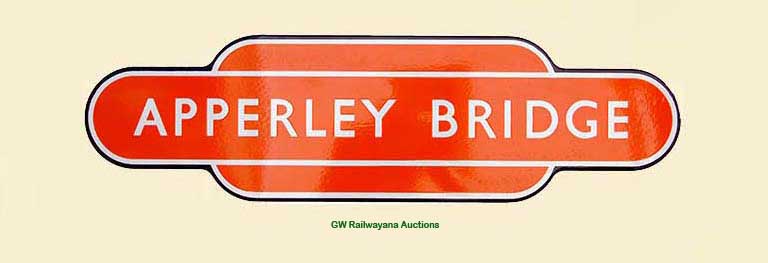
(Below) The permanent way gang responsible for the quadrupled section of track between Leeds and Shipley should be congratulated, because it was kept in immaculate condition during the Sixties. Today the standard of upkeep of the rail network is nowhere near as good, with sizeable weeds poking through the ballast between the sleepers. Now I'm not a keen gardener, but I do know that if weeds are left unattended they soon grow into the size of bushes, and they flourish in all kinds of places, not only on lightly-used rural branch lines, but also in the vicinity of busy main line stations. And it isn't because of some new anti-herbicide legislation either, but neglect. The permanent way is the very foundation of the rail network, and if weeds are allowed to clog the drainage, the ballast can become uneven and alter the alignment of track. It does give an altogether untidy look. Here Class 9F 2-10-0 No 92111 ambles through Apperley Bridge & Rawdon with a mixed goods for Healey Mills in March 1961. 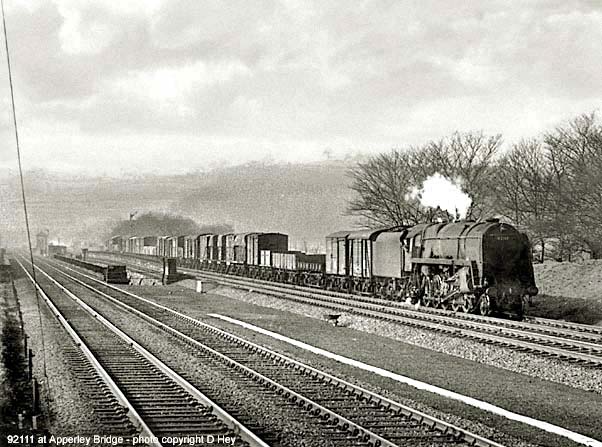

(Above-Below) Yet another shot of a 'Peak' Type 4 during driver training between Leeds and Applebly. Having departed Appleby at 12.55, D14 heads through Apperley Bridge on the return working to Leeds in March 1961. One of the amazing features of the Aire Valley Line is the way the railway blends into the landscape for much of its length between Leeds and Shipley. Beyond Apperley Bridge there's a lovely wooded area occupied by Esholt Sewage Works which until the 1960s had its own railway, with steam locomotives adapted to burn oil from wool waste. Apperley Viaduct signal box can be seen in the distance; this was a block post on the slow lines only which controlled the sidings for Esholt Sewerage Works.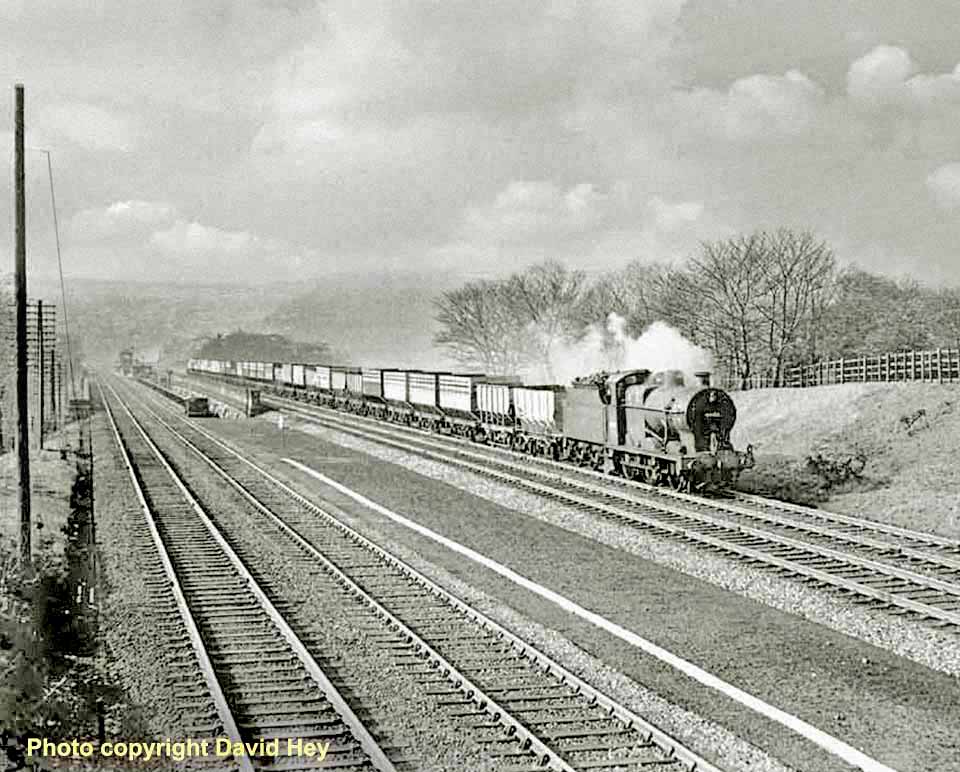

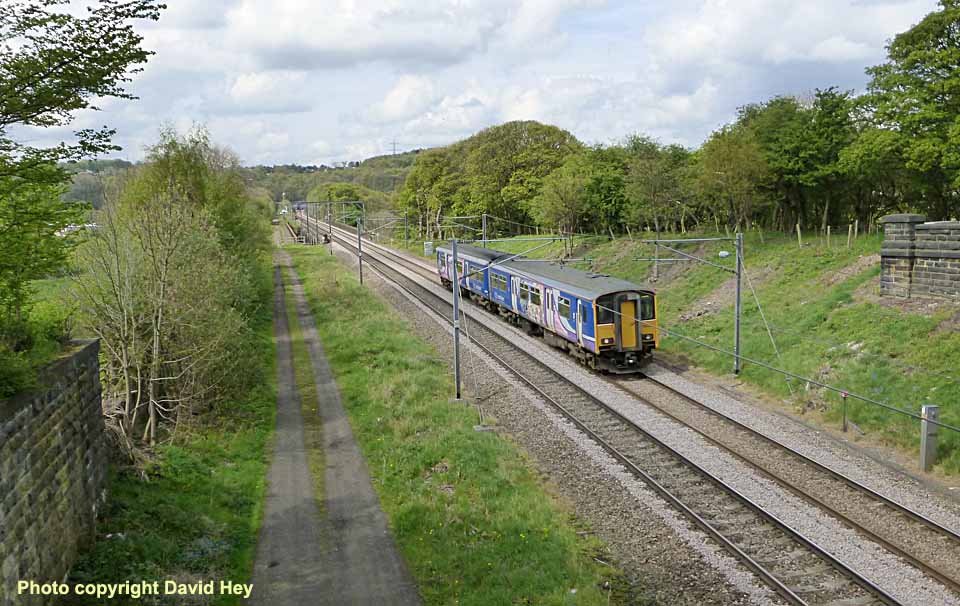
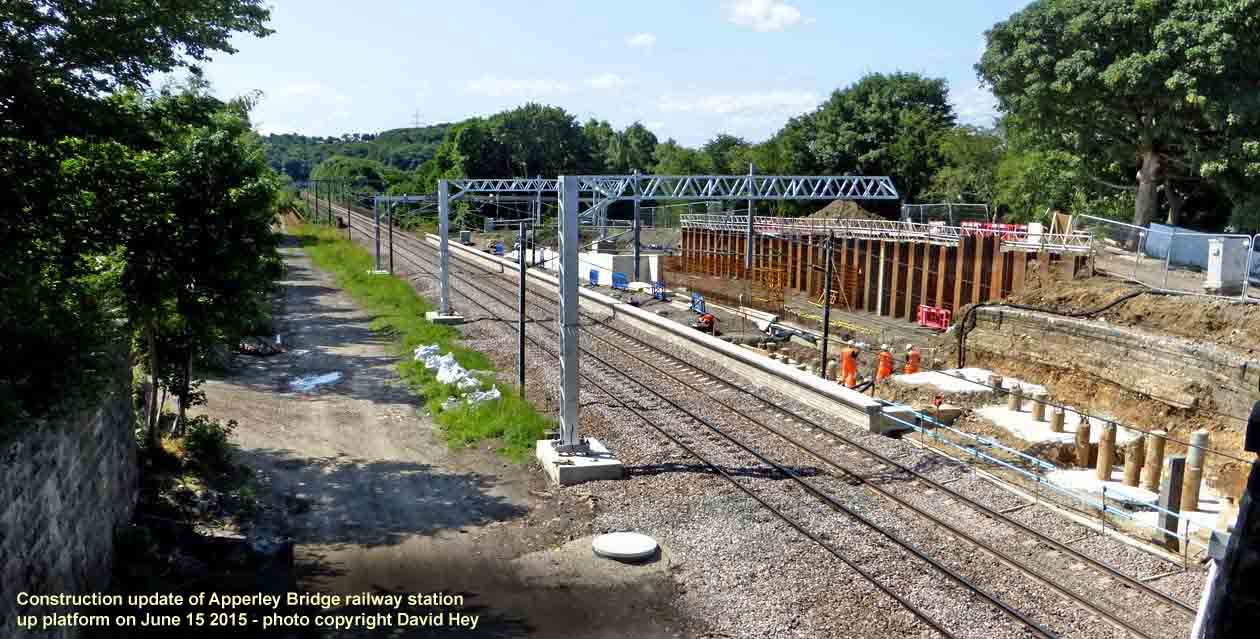
(Above-Below) This is a very brief history of the new Apperley Bridge station - the full history can be found elsewhere on the web. In 1999 Metro put forward proposals to open several new railway stations in West Yorkshire. In September 2008, the Yorkshire & Humber Regional Transport Board approved funding towards the West Yorkshire Passenger Transport Executives WYPTE's rail growth programme; this included plans for new stations at Apperley Bridge and Kirkstall Forge on the Aire Valley line. A planning application for the new station at Apperley Bridge was submitted in December 2009 and planning consent was granted by the City of Bradford Metropolitan District Council in March the following year. Final approval was given by the Department for Transport on 29 May 2014 and construction work began in September 2014. The station is expected to open in August 2015. Please note, these photos are actually dated 15 July 2015 - not June 15 as stated in the shots. The station will be served by two trains per hour each way with extra trains at peak periods. The new facilities include a new access road and a dedicated pick up-drop off point; a station car park for 300 vehicles, fully-accessible platforms with both staircases and ramps; CCTV surveillance; passenger information displays and public address system - and modern waiting shelters.
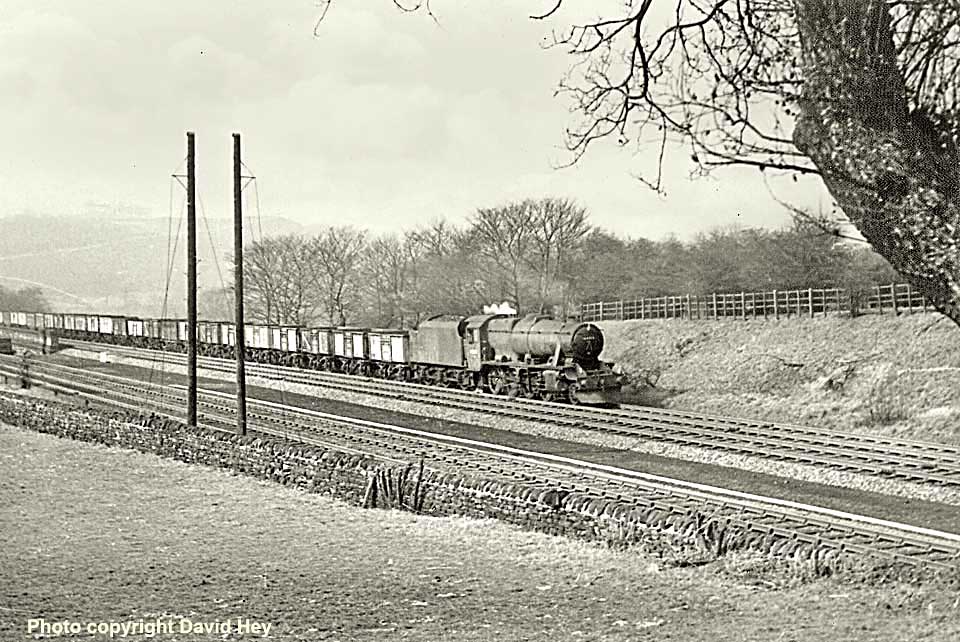
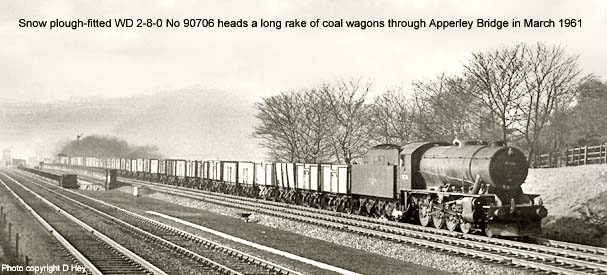
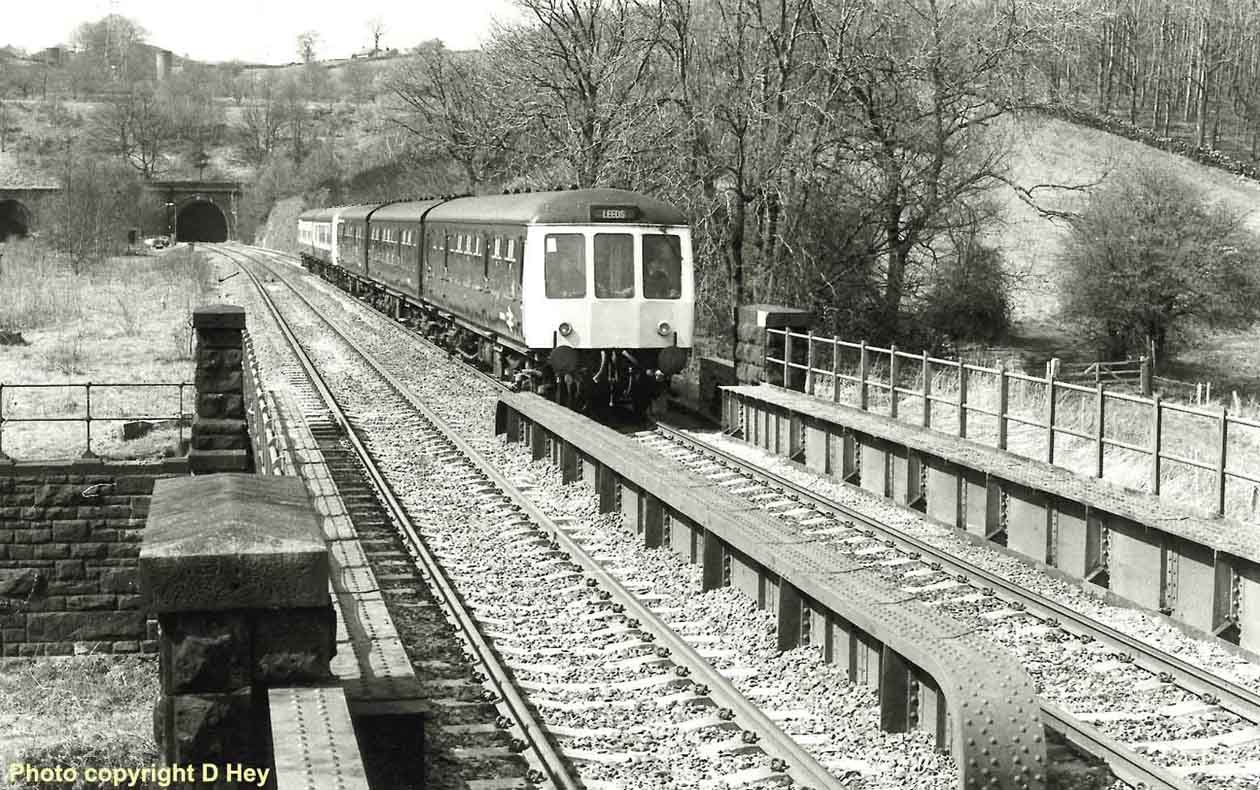
(Above-Below) Beyond the signal box the 1,496 yard-long Thackley Tunnel avoids a circuitous route followed by the canal and river, both curving away around the hillside before rejoining the railway for the final mile into Shipley. A skipton-Leeds dmu rattles out of the eastern portal of the tunnel and crosses the Leeds-Liverpool Canal. (Below) Class 47 emerges from the Shipley end with the 16.10 Leeds-Carlisle in June 1983; with four Mk1 coaches on the drawbar is child's play for a Type 4 locomotive.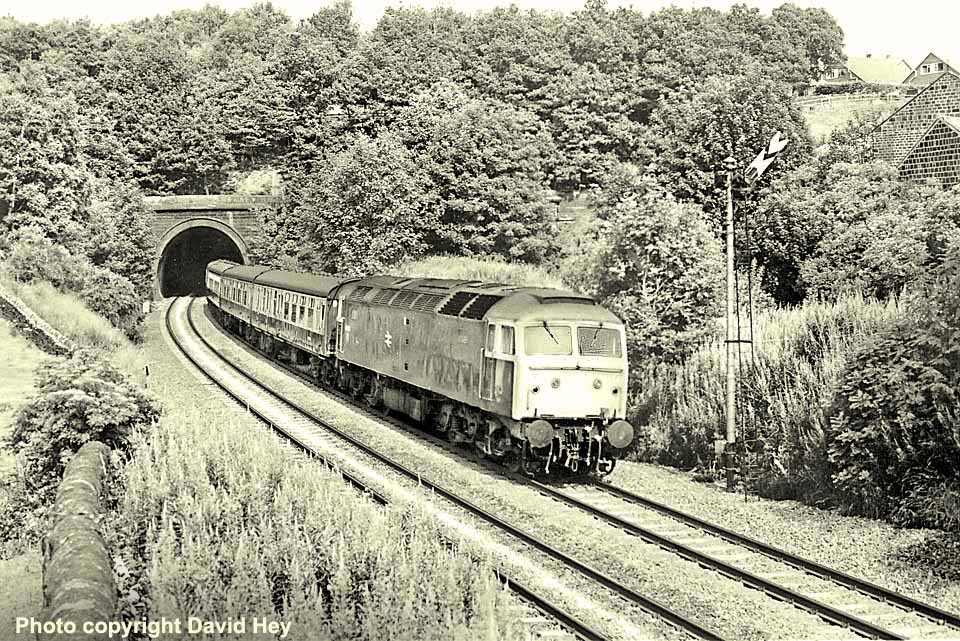
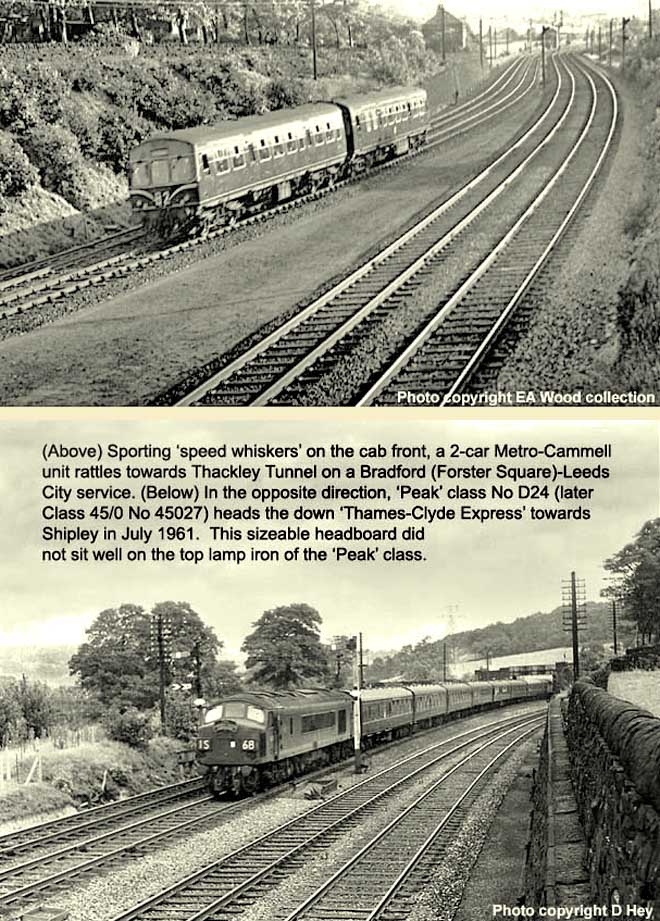
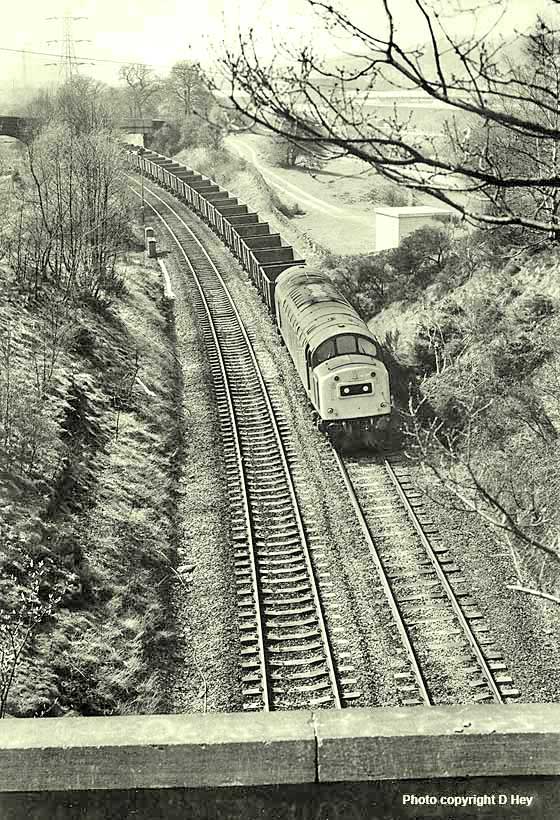
(Below) The LMS 6P5F 2-6-0 'Crab' was essentially a Hughes design built under the direction of Sir Henry Fowler. The angled cylinders necessitated raising the front portion of the running board, which gave the parallel boiler a squat appearance between the frames and earned the 245 members of the class the nickname 'Crabs'. The first engine didn't emerge from Horwich works until after Hughes retired as CME of the LMS in 1925 and his successor, Henry Fowler, made several changes to the original plans, including the pairing of a much narrower tender. A group of spotters note down the number of No 42895 heading a light parcels train out of Thackley Tunnel between Leeds and Shipley in June 1963. 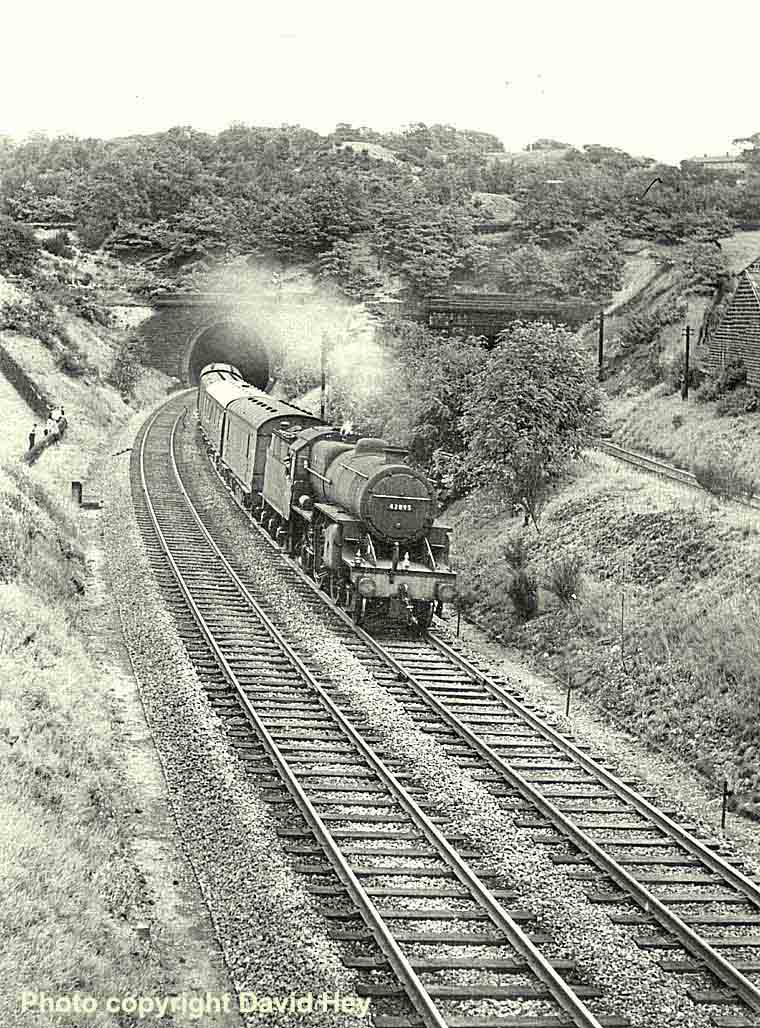
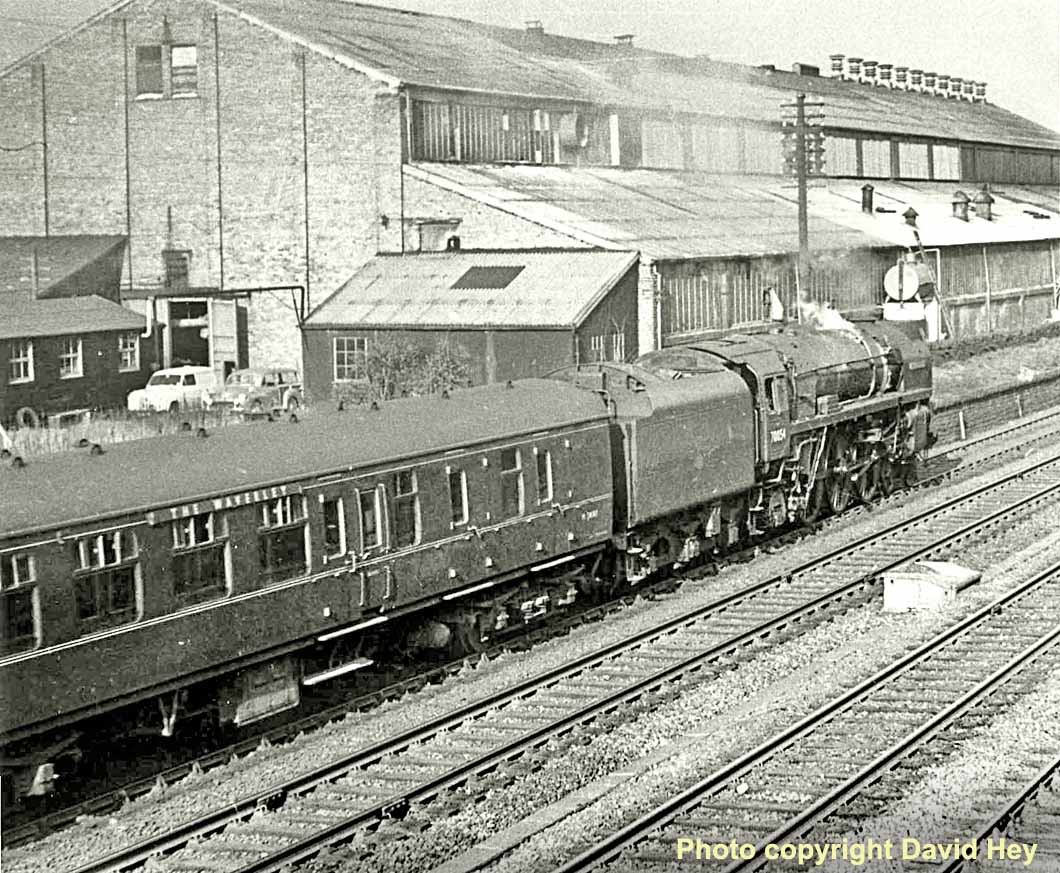
(Above-Below) Compared to the frenetic jostling of elbow room between today's rat pack of steam cameramen, a visit to the lineside was largely a leisurely pursuit in the early Sixties…at least, that's how I remember it. I grabbed these shots at Shipley on 9th March 1961; the Valley Scouring & Carbonising Co Ltd factory dominates the background in this shot of 'Britannia' class No 70054 Dornoch Firth heading the 'up' Waverley towards Leeds. (Below) Class A3 No 60092 Fairway approaches Shipley with the northbound 'Thames-Clyde Express'. 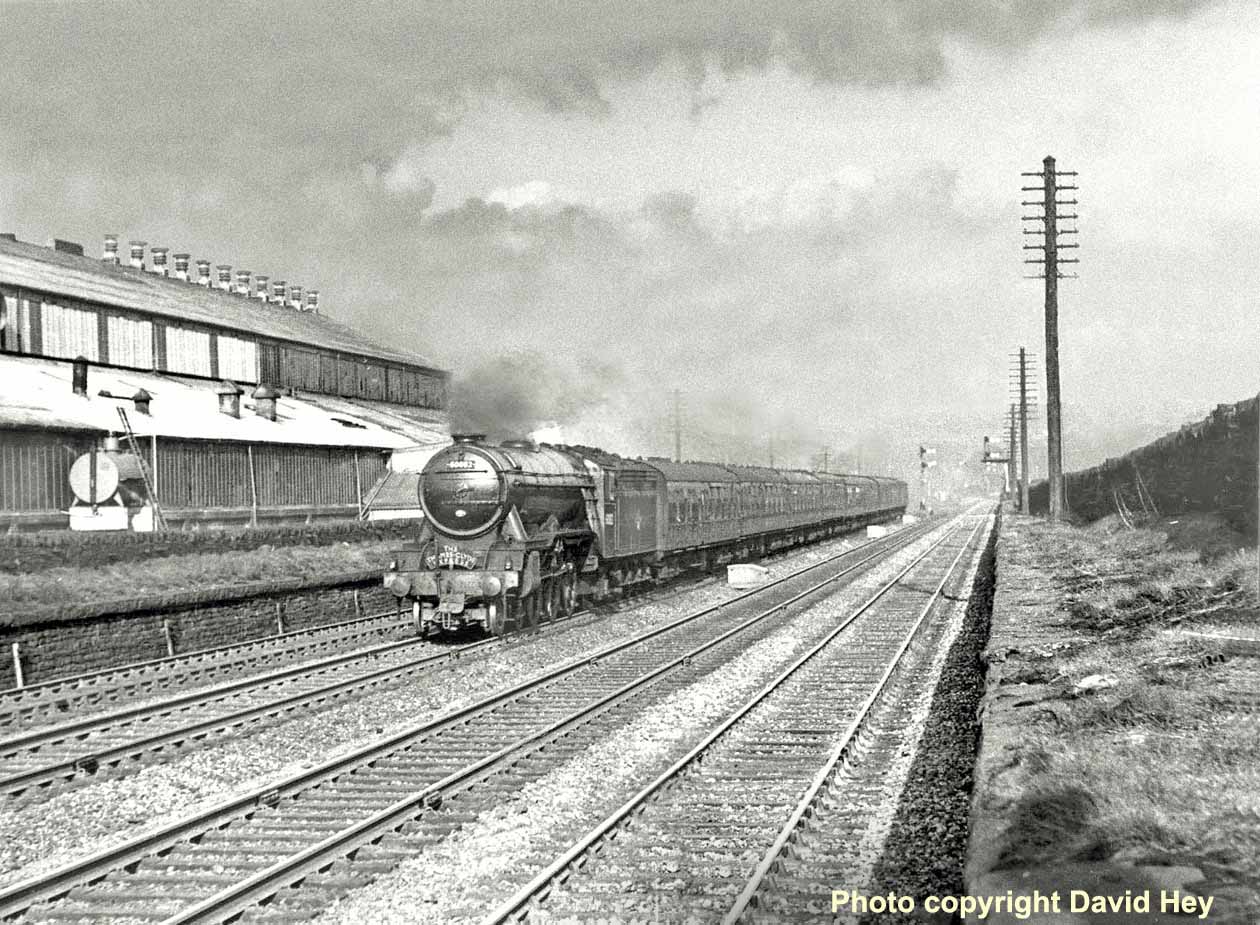
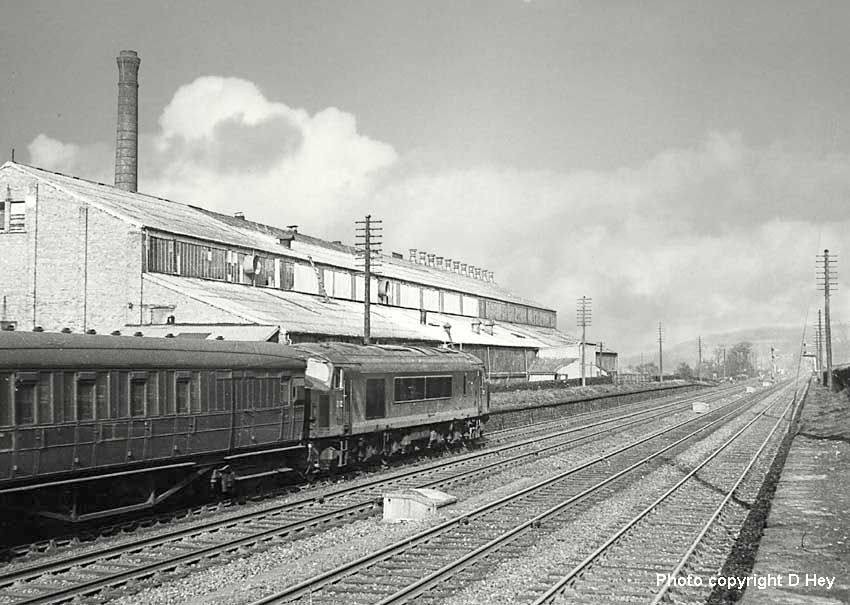
(Above-Below) With only weeks to go before the introduction of 'Peak' class Type 4s on the Anglo-Scottish expresses north of Leeds, During the training programme for Holbeck crewmen, D12 heads in interesting collection of articulated coaching stock on the return run from Applebly to Leeds. (Below) Fast-forward 20-odd years and the scene has radically changed; the Valley Scouring & Carbonising Co Ltd factory has gone and nature again occupies the tract of land between the railway and Leeds-Liverpool Canal. Here, a Leeds-Skipton dmu is strengthened to a pair of twin Metro-Cammell units in July 1983. 
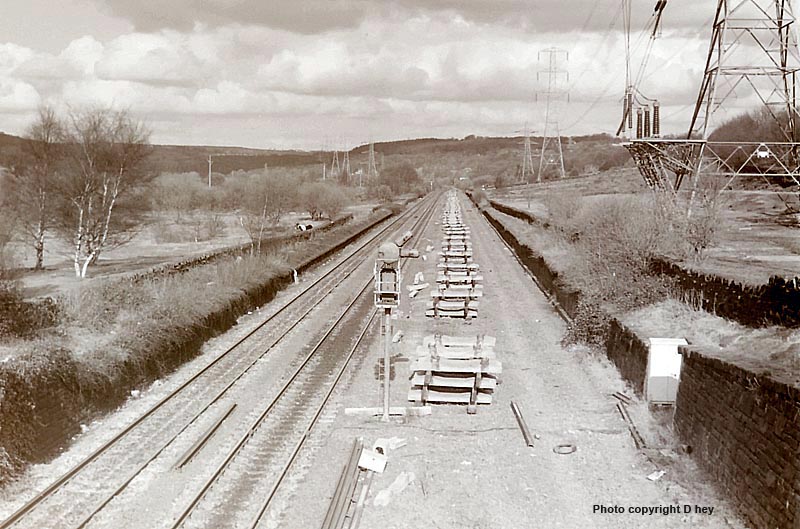
(Above-Below) 1980s rationalisation at Shipley with redundant track awaiting removal. Just visible through the piers of the electricity pylon on the right is the abandoned trackbed of the Great Northern Railway line from Laisterdyke to connect with the MR at Shipley. (Below) A 2-car dmu on the Leeds City-Bradford Forster Square service slows for the obligatory stop at Shipley. In the distance can be seen the timber-built Guiseley Junction signal box where the line from Ilkley trails in from the left, and on the right is the stone-built GN Shipley Junction signal box which controlled train movements at Windhill Station, terminus of the GNR's branch from Laisterdyke on the Bradford Exchange-Leeds Central line. Just visible beyond the bridge is the foot of the torturous gradient which rises at 1 in 61 for two miles to the summit at Idle. Opened in April 1875 the branch gave the Great Northern Railway access to the MR at Shipley, its main traffic being coal from the Wakefield area with up to seven freights daily; passenger services were withdrawn on 2 February 1931 but the line remained open for goods traffic well into the 1960s, the last section to close being the two mile gradient between Idle and Shipley for transporting limestone from Idle Moor quarry until October 1968. The GNR branch joined the Midland Railway at Leeds Junction signal box at the eastern apex of Shipley station's triangular junction.
(Below) A bit of jiggery-pokery in Photoshop shows preserved 'Jubilee' class No 5690 Leandor heading a Carnforth Steamtown Special on 12th April 1982. 
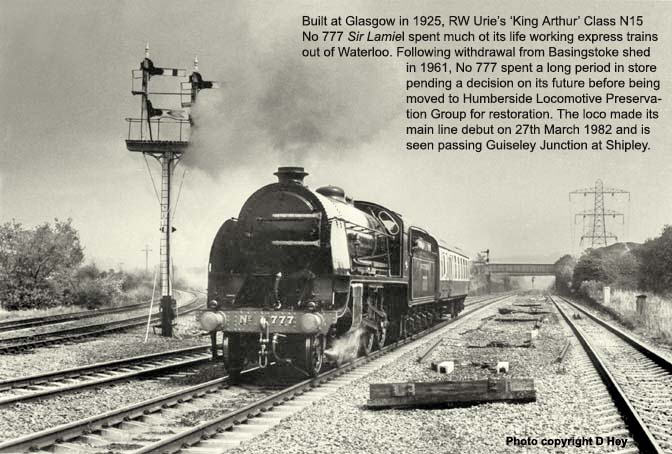

(Above-Below) The triangular layout of the station at Shipley has taken more than 130 years to evolve. It began in September 1847 when the L&BRC created a junction on the Leeds-Bradford line to accommodate the railway's extension to Keighley and Skipton; by this time the L&BRC had been taken over by the Midland Railway. Platforms were provided on the Bradford to Leeds curve and the Bradford to Skipton curve, but the Leeds-Skipton main line remained 'platformless' until May 1979. Previously trains on the local Leeds-Skipton service had to pass through the Leeds-Bradford platform then reverse into the Bradford-Keighley platform, involving signalmen in no end of lever-pulling and clanging of bells at both the Shipley-Bradford Junction box (above) and Shipley-Bingley Junction box (below) plus the driver had to change ends; similarly the operation was reversed for 'up' trains. However, when visiting Shipley in the 1970s I recall the local dmu passenger service between Leeds and Skipton passing beyond Shipley-Bingley Junction then reversing into the Bradford-Keighley platform, still a time-consuming manoeuvre which wasn't eliminated until May 1979 when a new bi-directional platform was opened on the Leeds-Skipton curve. This meant that local stopping trains from Skipton to Leeds had to switch from the 'up' to the 'down' line' to reach the single platform; a clumsy operation that remained unresolved until a new platform on the 'up' line (to Leeds) was opened in 1992. I hope this caption is making sense! Shipley is now one of two triangular stations in the UK: the other being at Earlestown in Merseyside.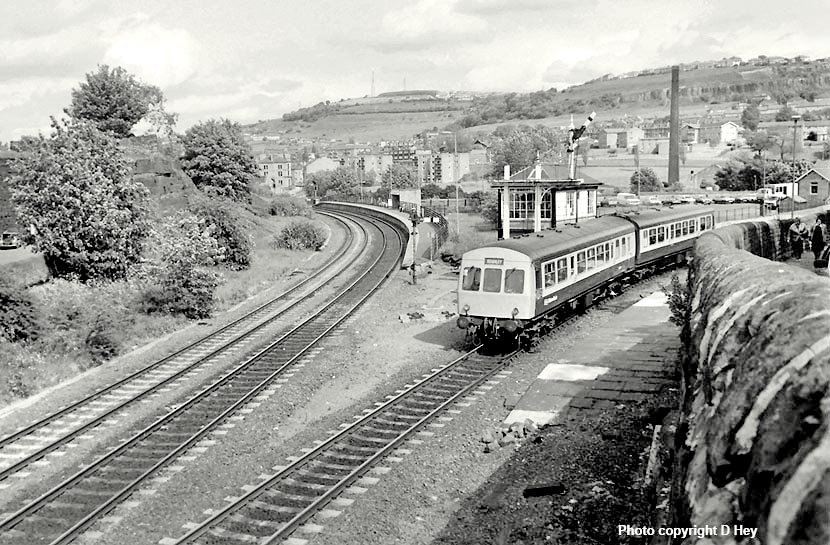
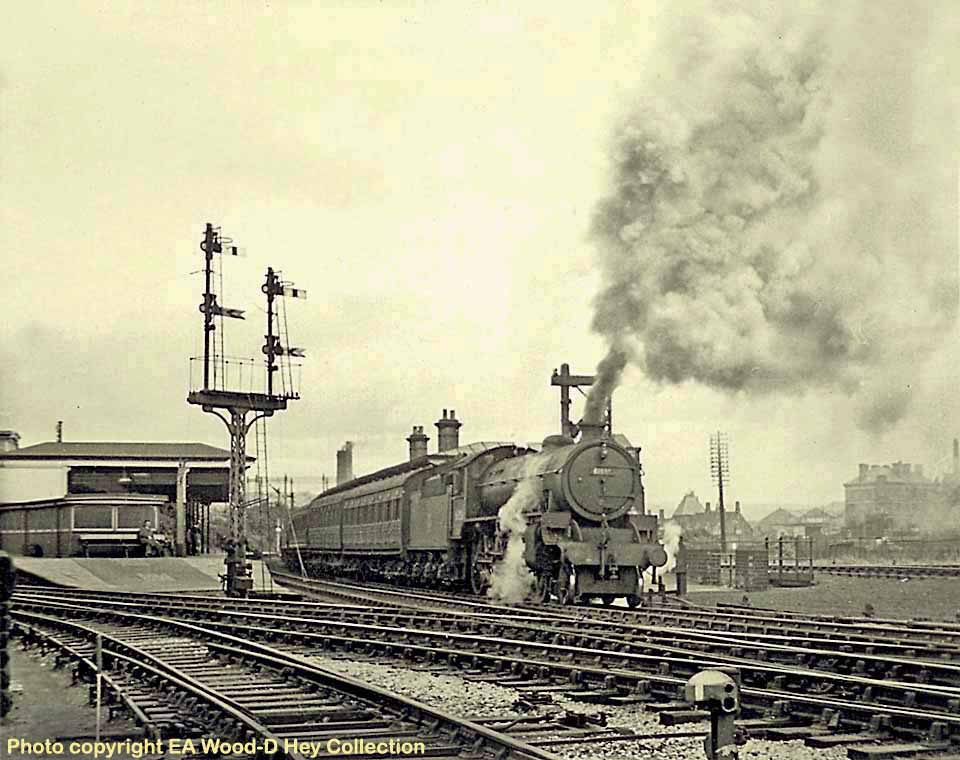
(Above-Below) In 1952 each BR Region deployed coal-weighing tenders enabling engineers to accurately record a locomotive's coal consumption. The tenders were equipped with a separate bunker suspended on pivots which were connected to steelyards; the bunker assembly was fixed when the loco was working and released when the contents of the coal space was weighed. The quantity of coal used on the test was measured by weighing the coal deposited in the tender prior to starting, then during the test and the residue was weighed again at the end of the run. The weight difference, taking into account the amount used for lighting up, gave the total consumption over the route. British Railways Eastern Region constructed four coal weighing tenders to be used in conjunction with dynamometer car tests but the testing of coal consumption was often carried out on its own. With the advent of dieselisation the tenders fell into disuse and reverted back to their original form. Here Class B1 No 61086 slips whilst restarting a train for Bradford Forster Square. The goods lines on the far right were taken out of use between 1969 and 1970. (Below) For good measure here are examples of the self-weighing tenders used by the BR London Midland Region. 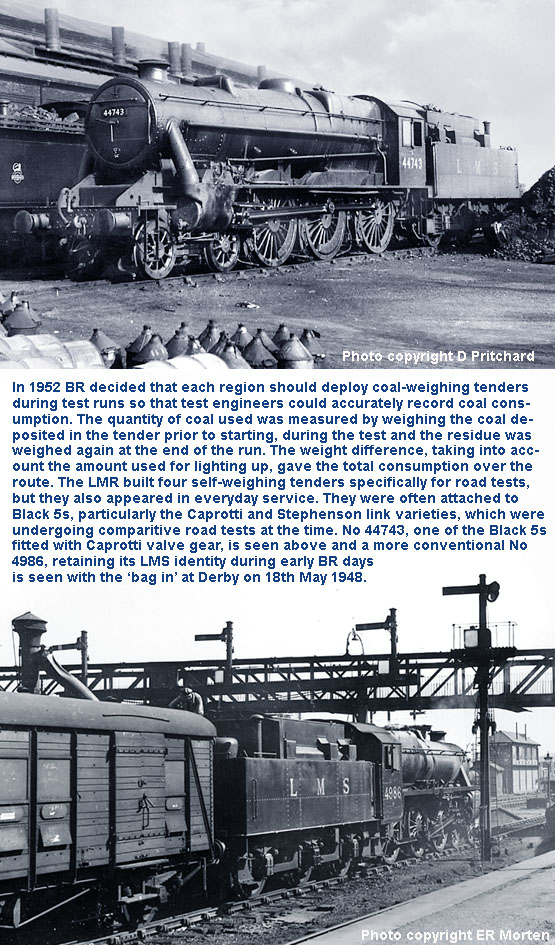
NEXT PAGE - BRADFORD FORSTER SQUARE TO SKIPTON...STILL UNDER CONSTRUCTION
Polite notice: All text and photographs are protected by copyright and reproduction is prohibited without the prior consent of the © owners. If you wish to discuss using the contents of this page the email address is below. Please note - this is not a 'clickable' mail-to link via Outlook Express. You will have to email manually.
dheycollection@ntlworld.com




